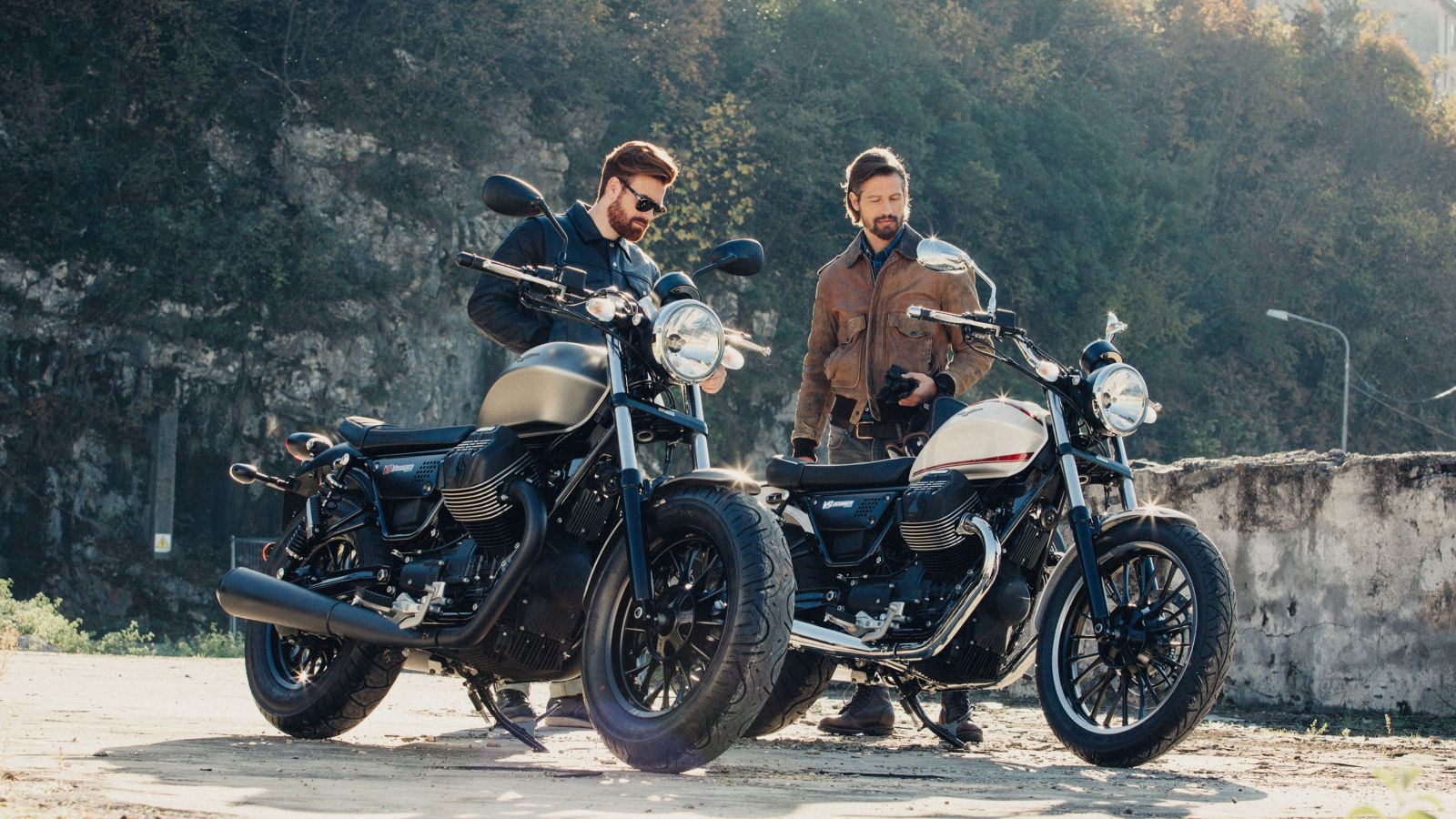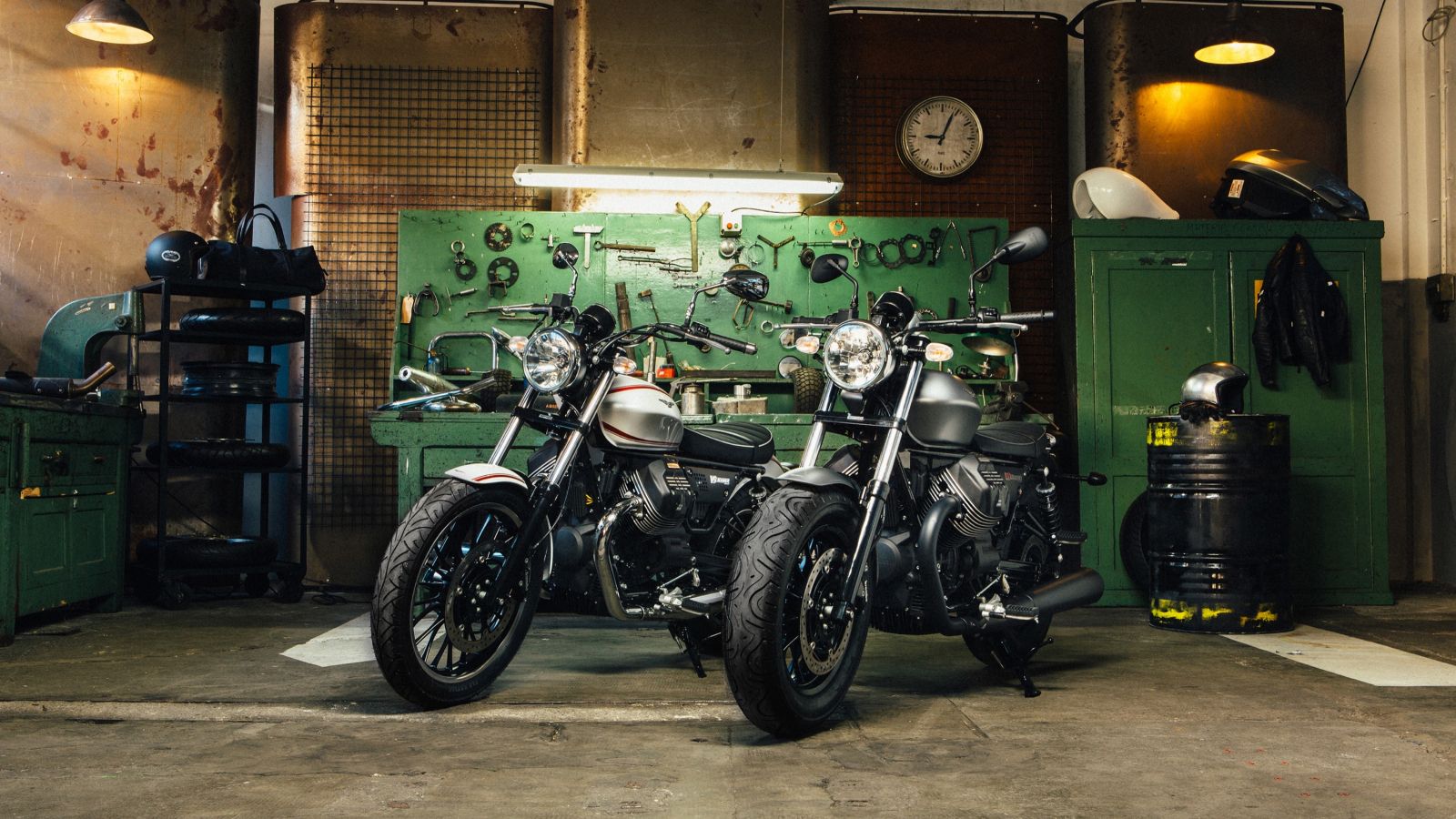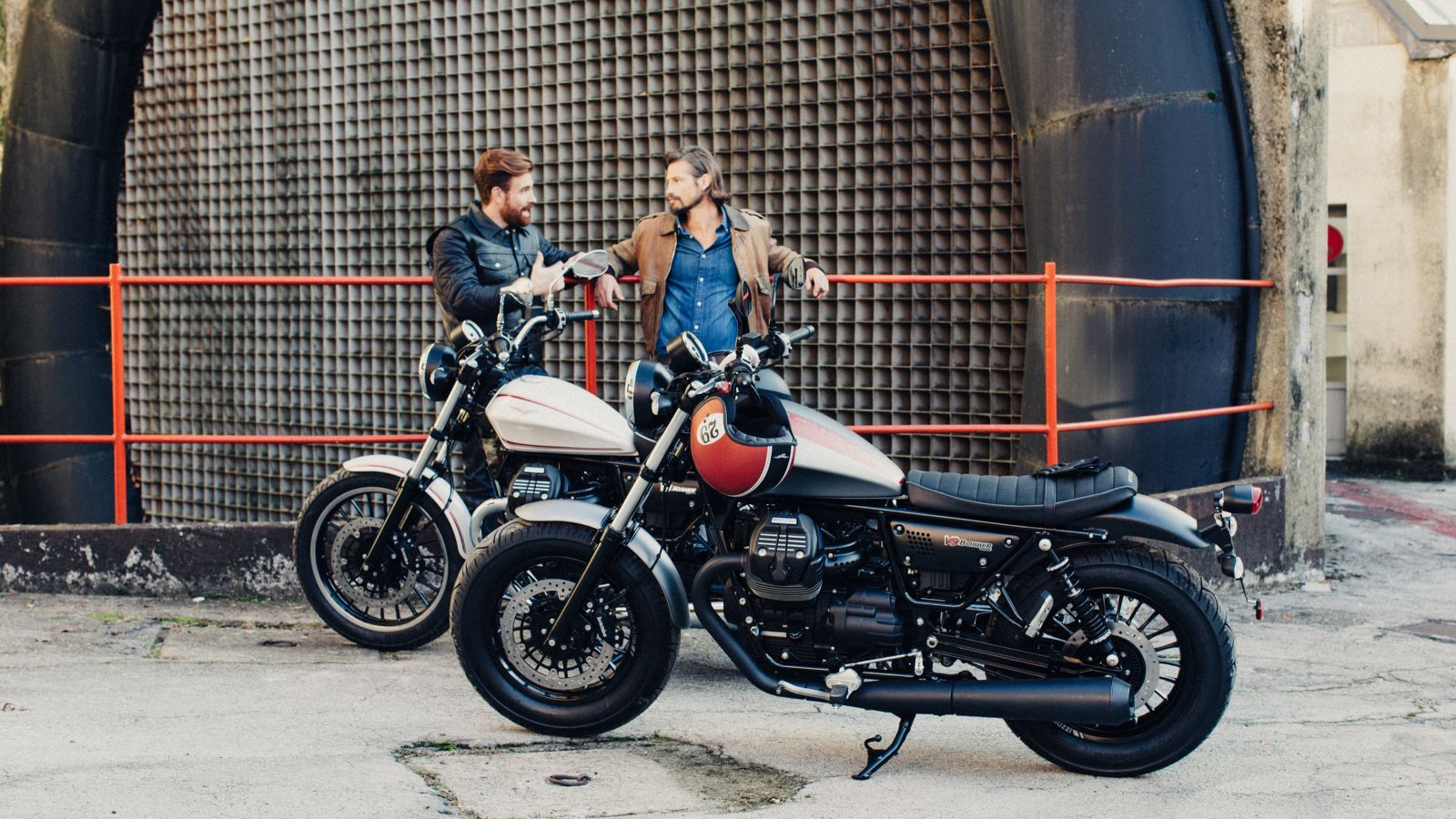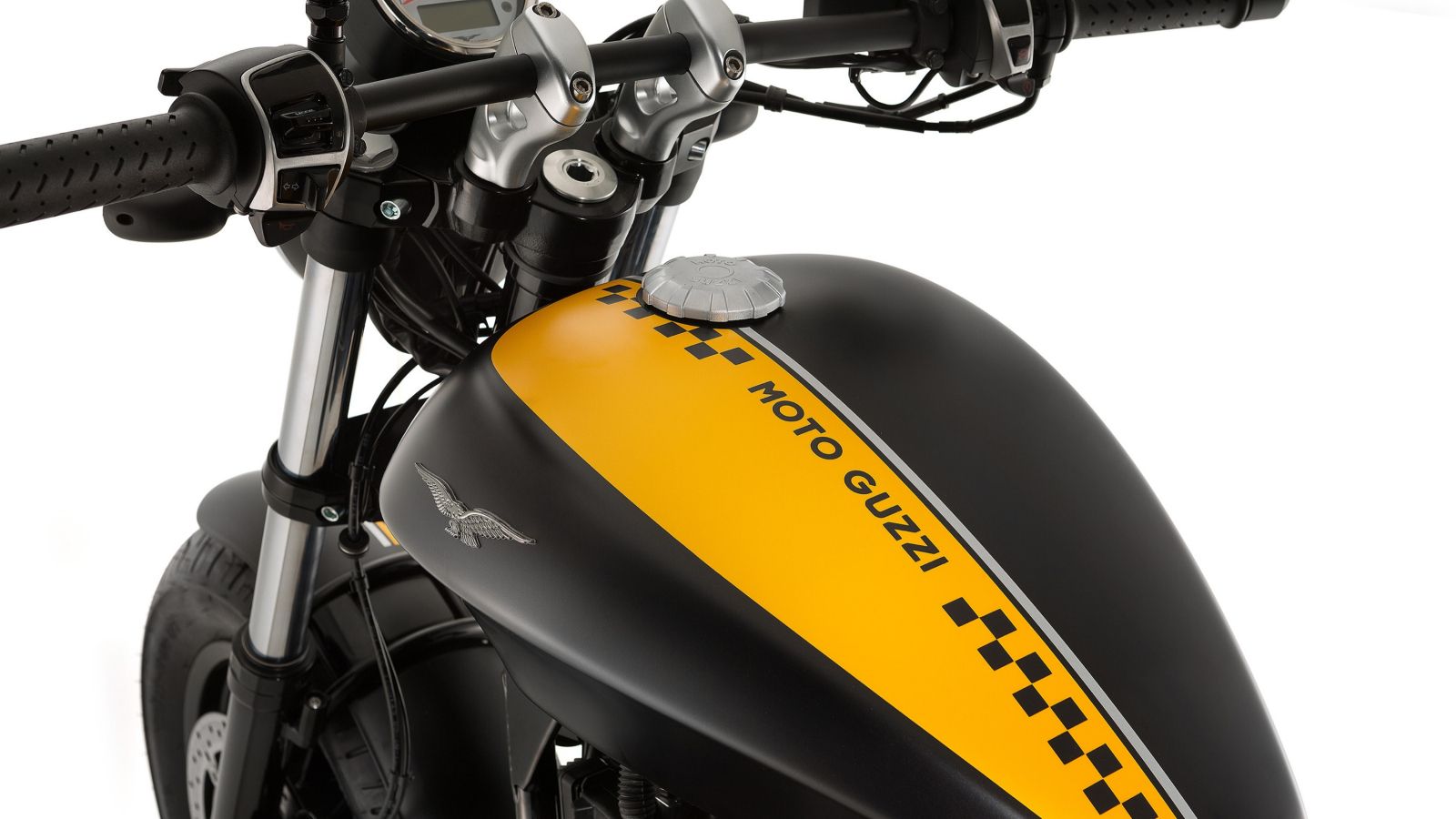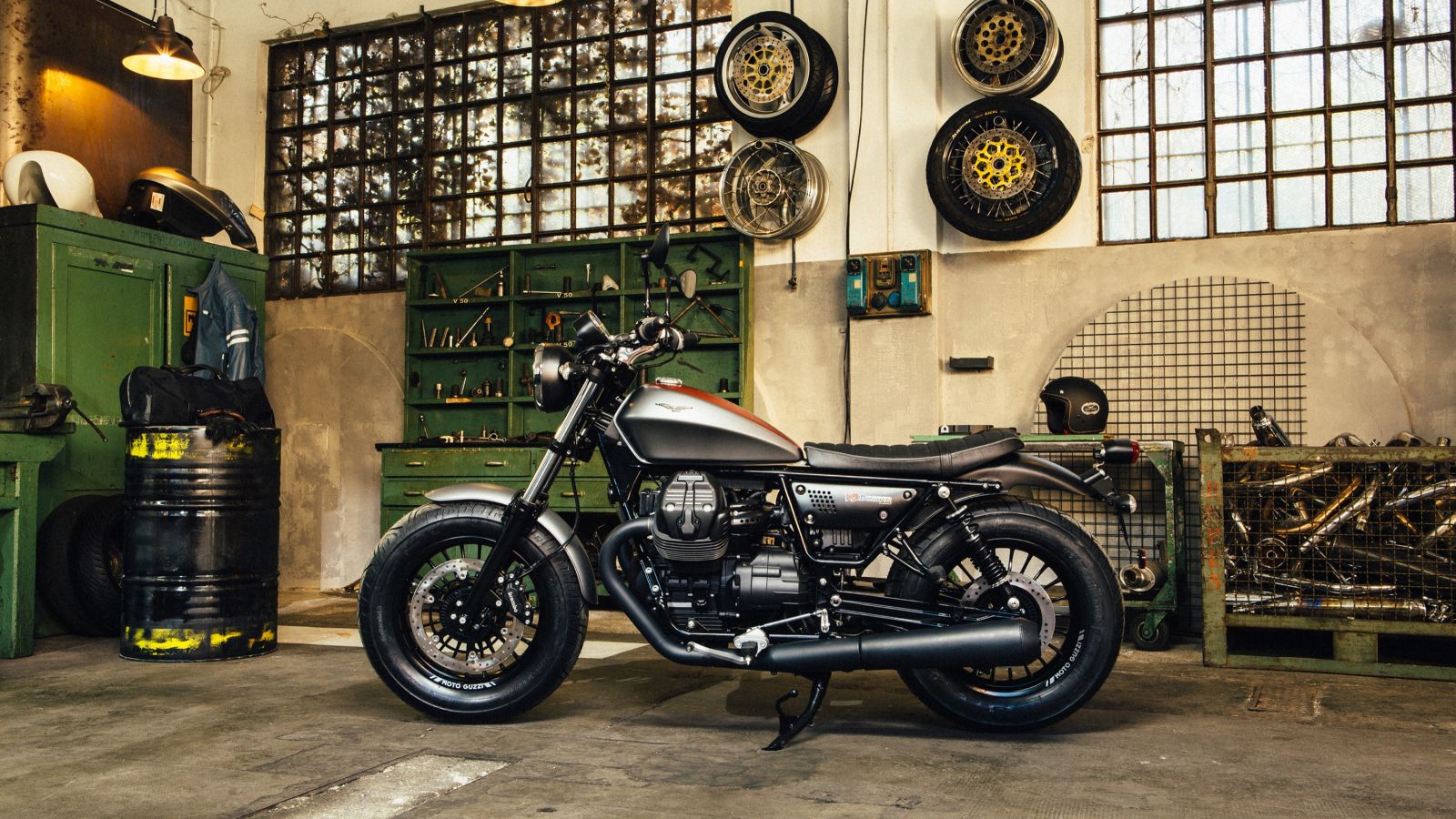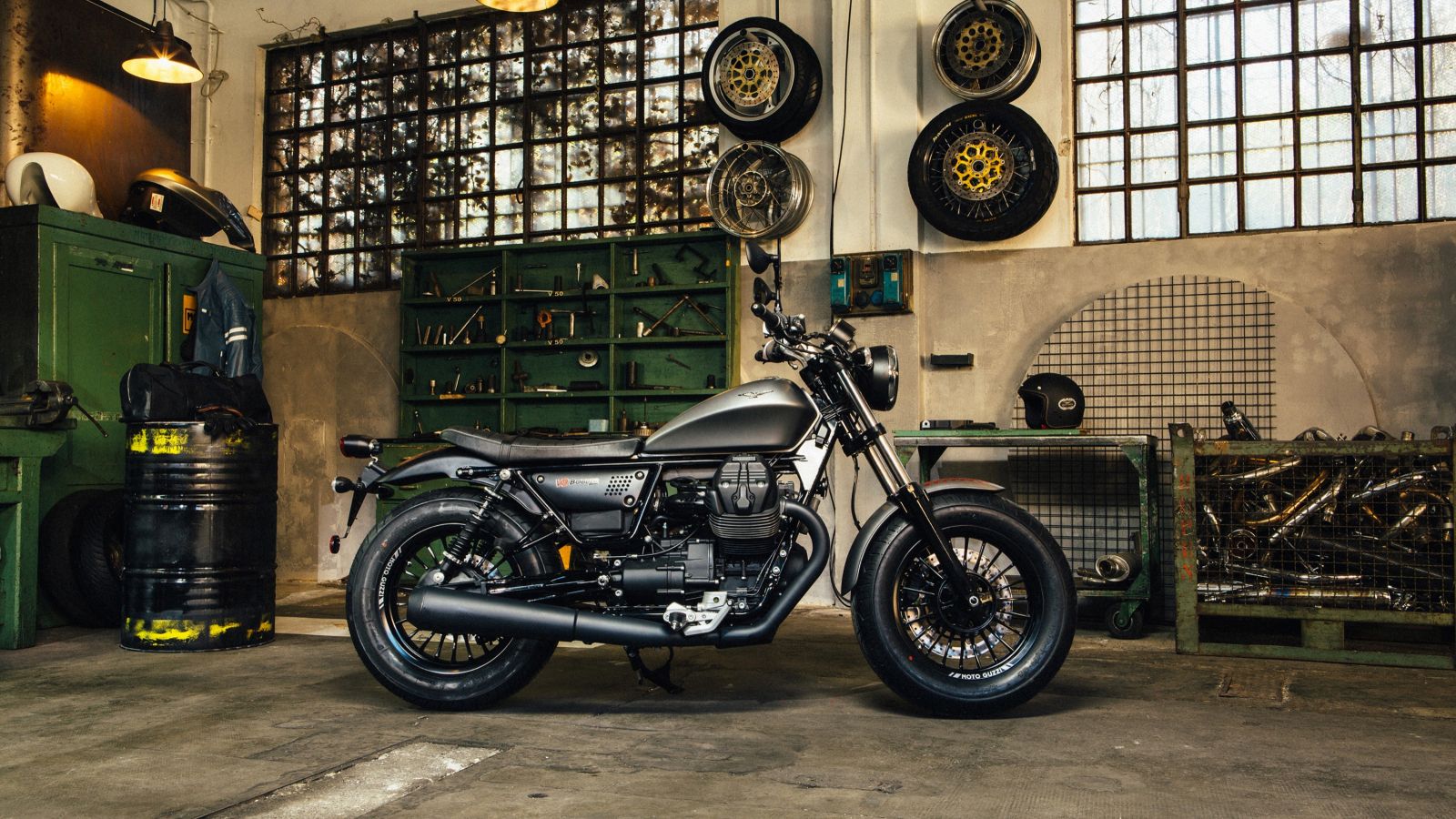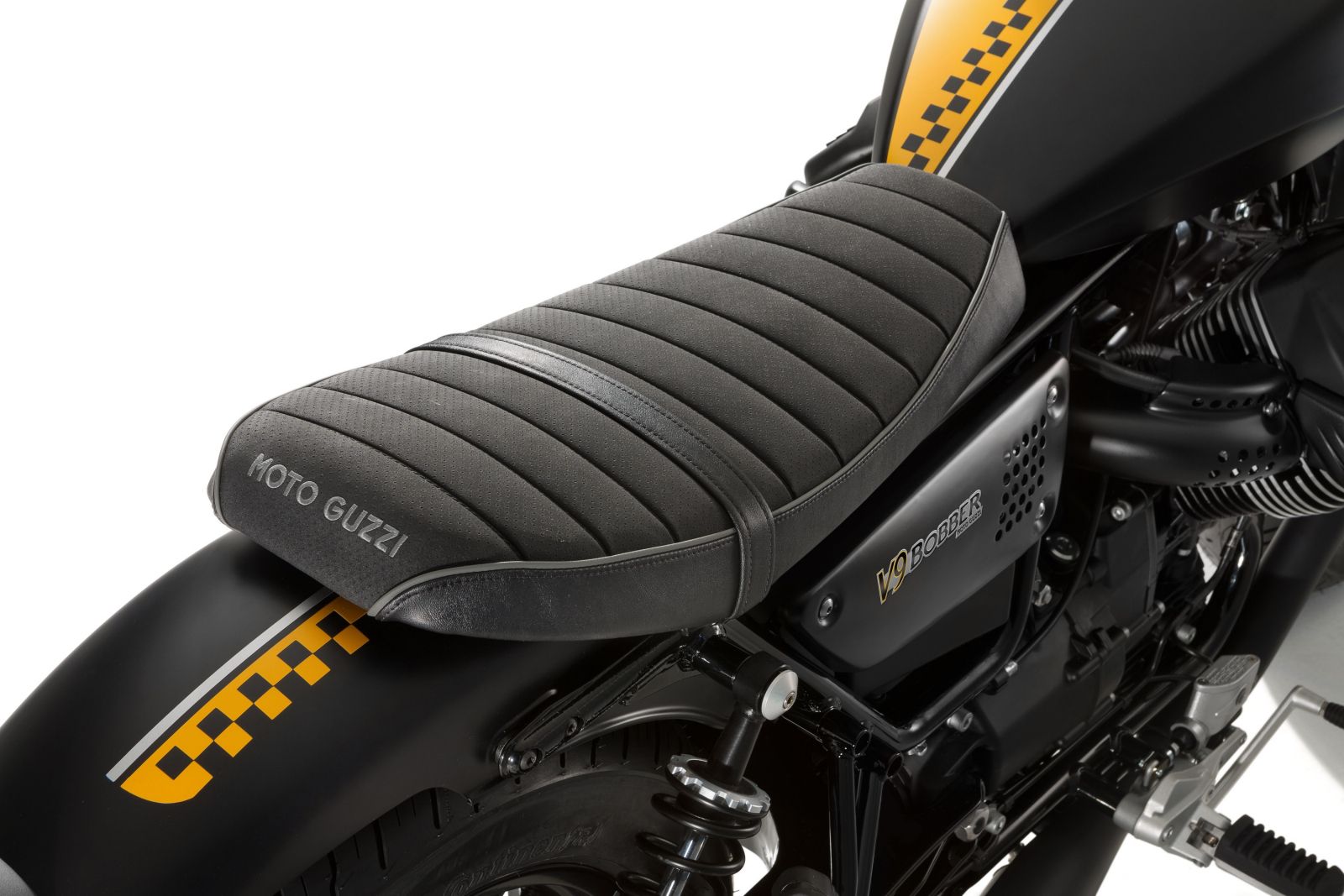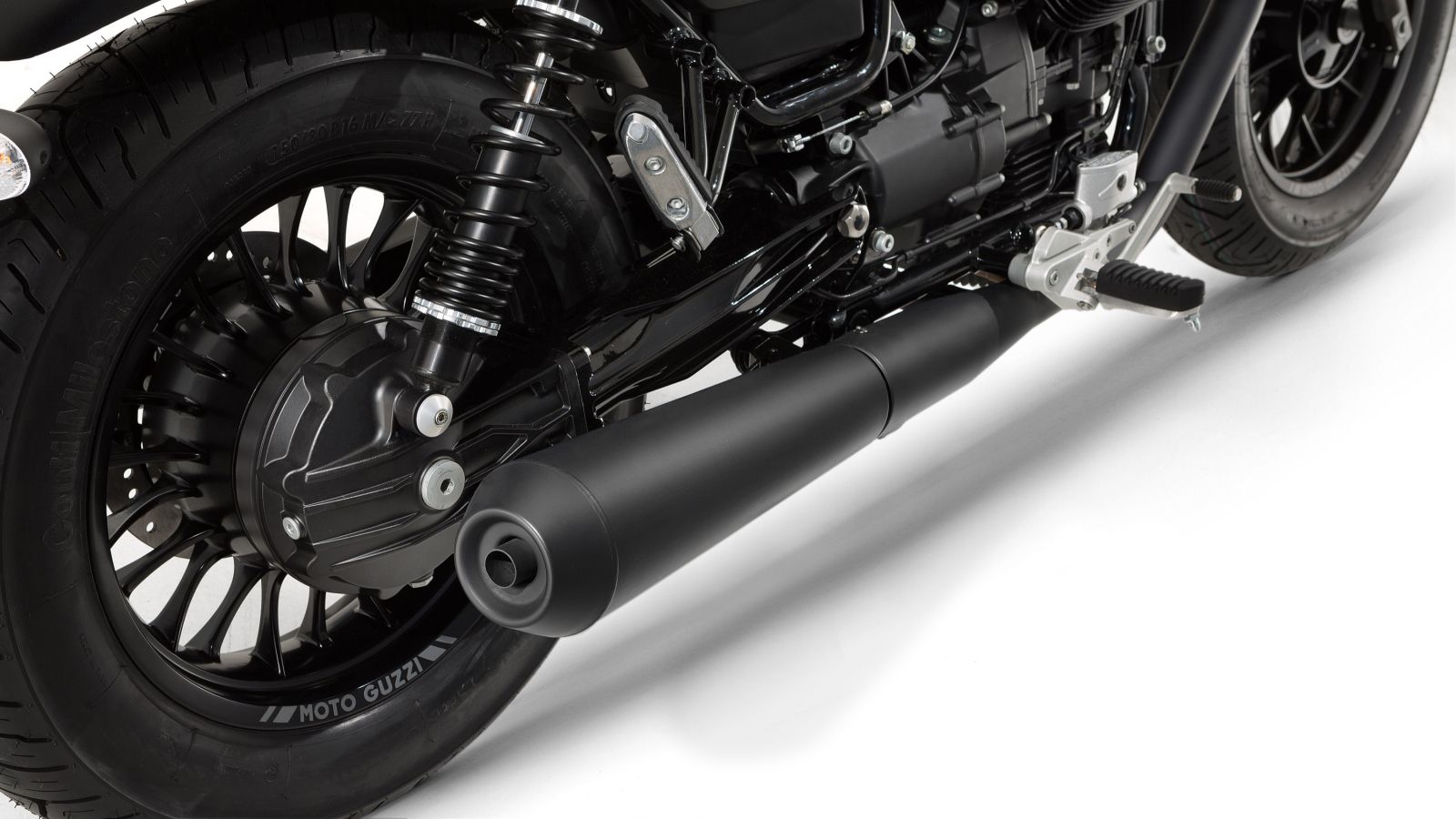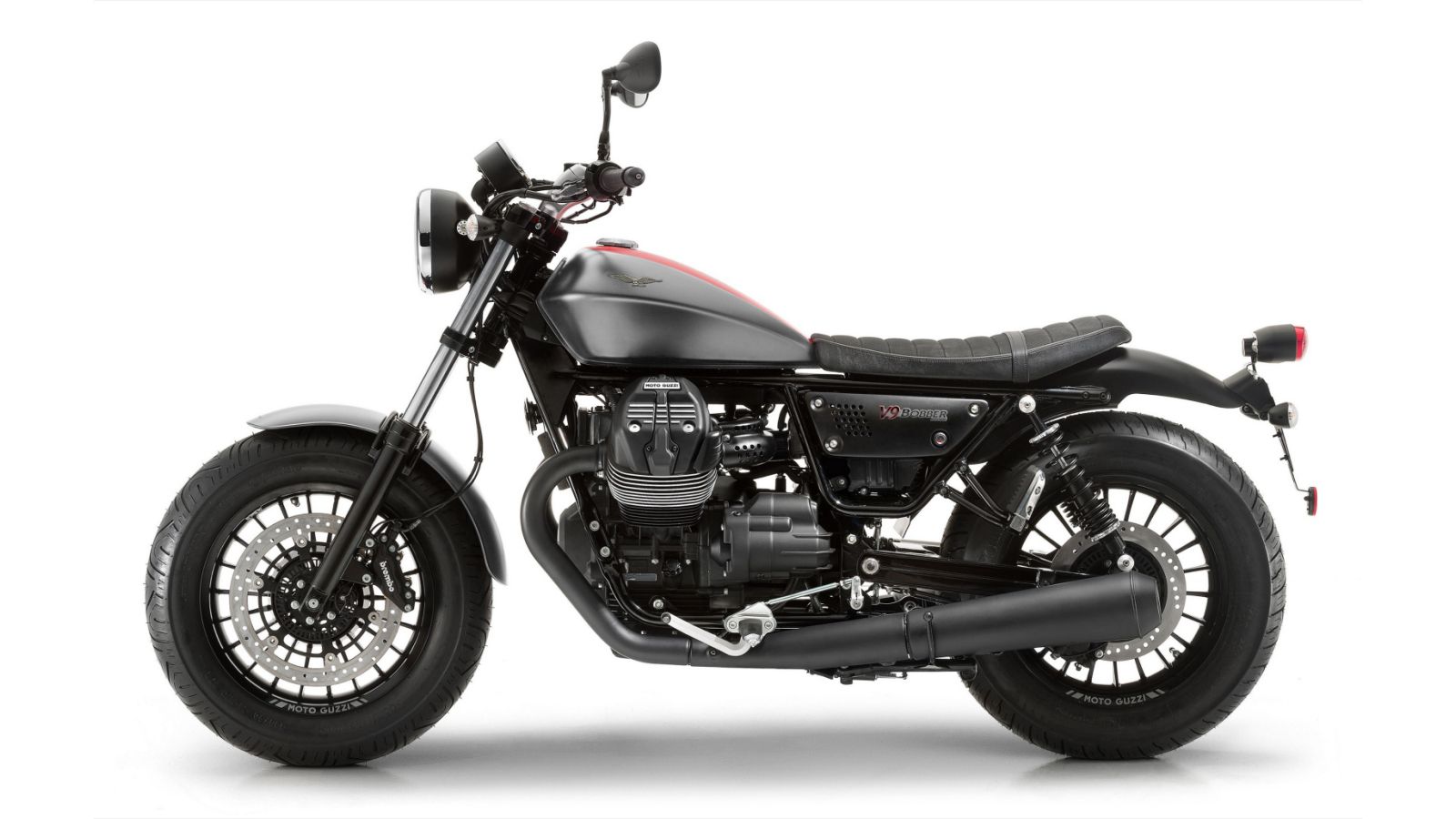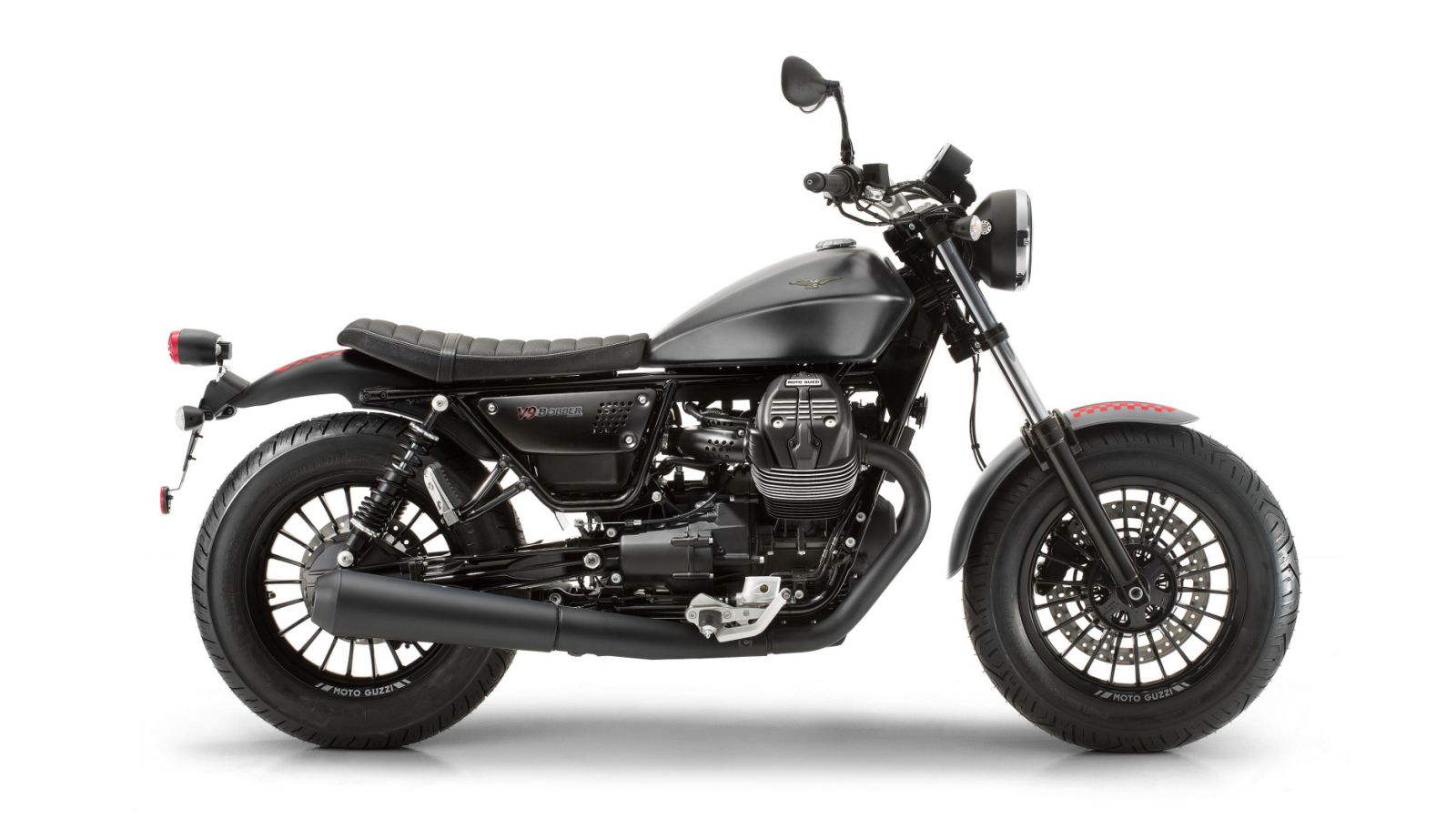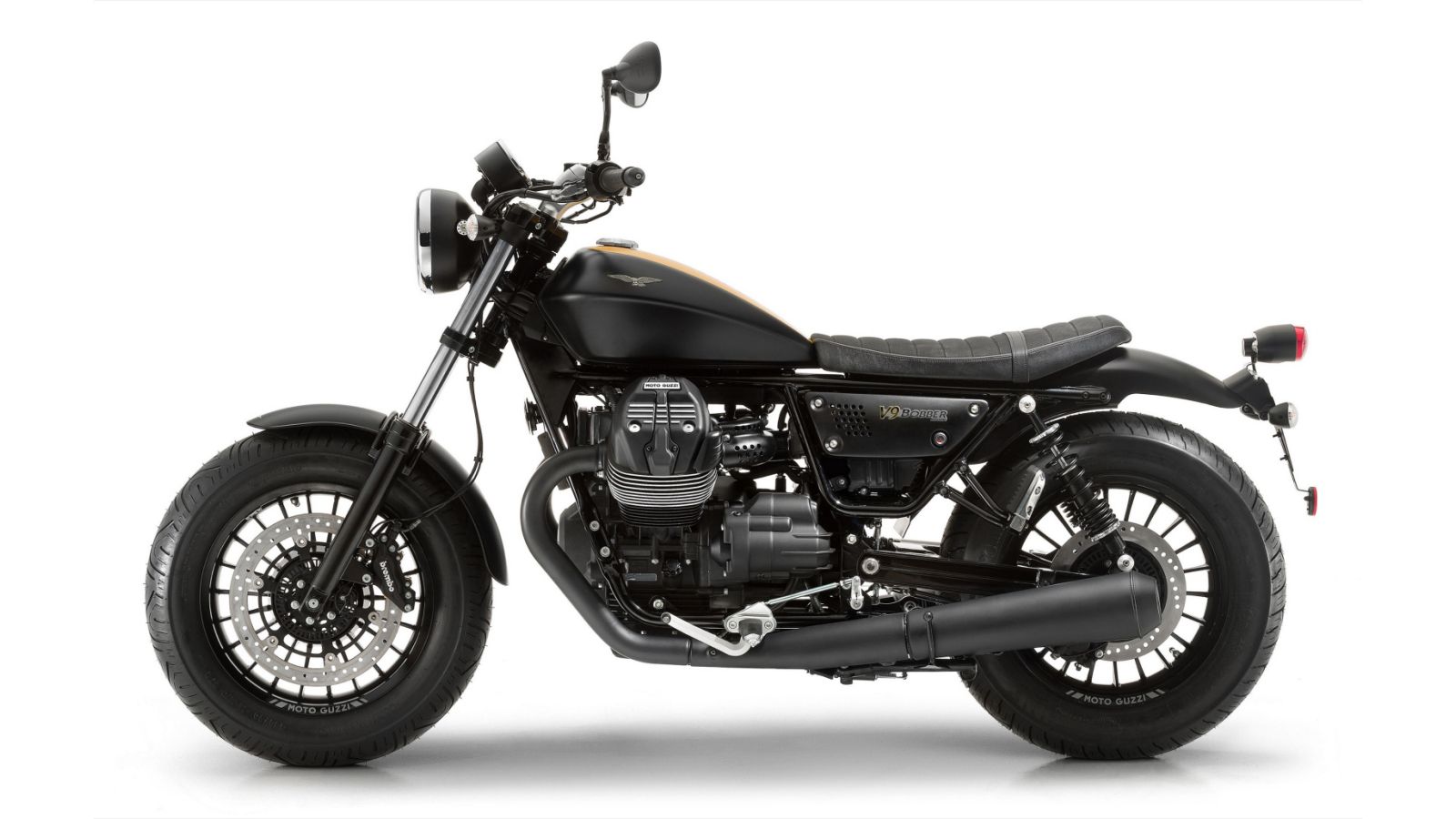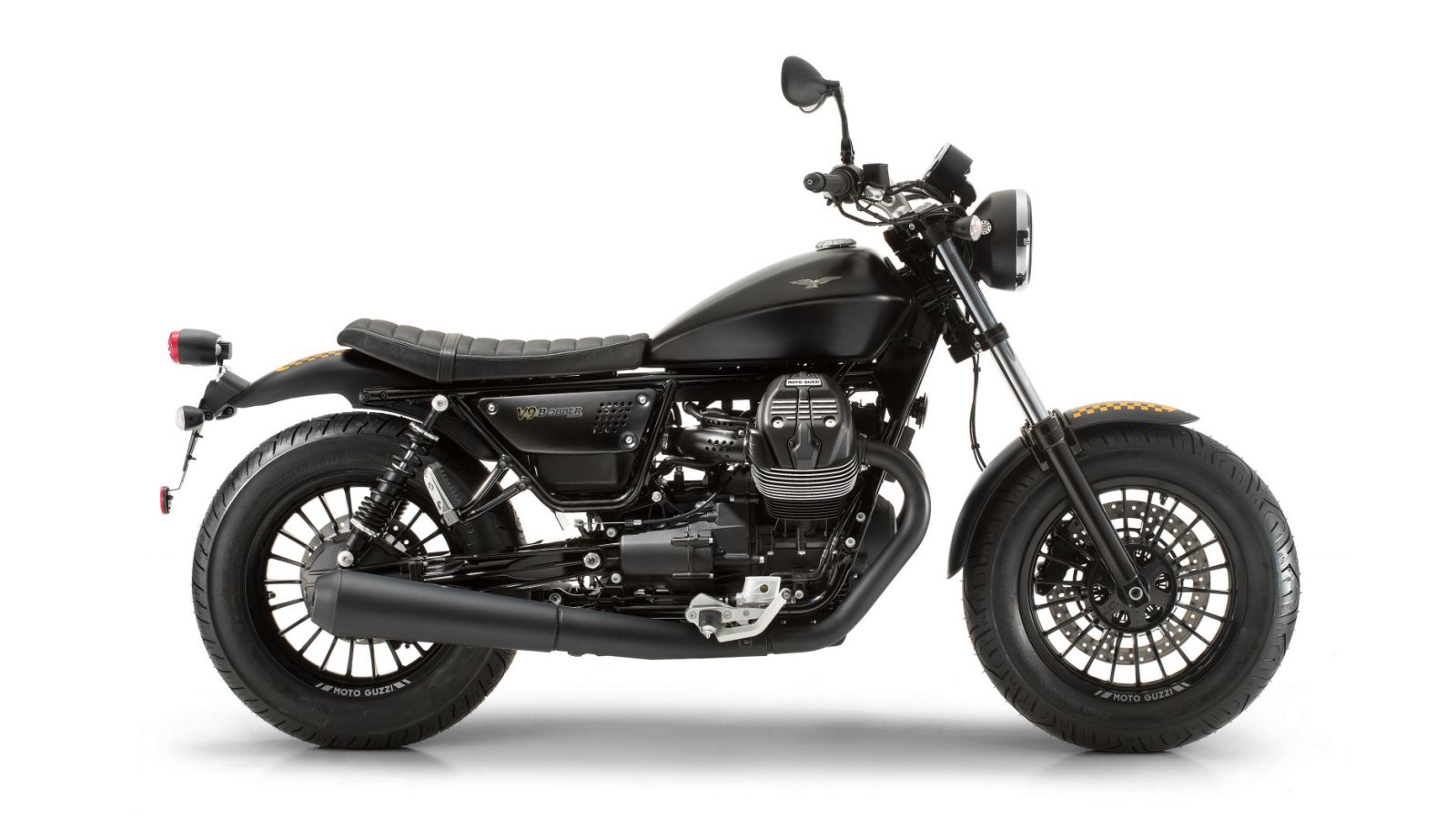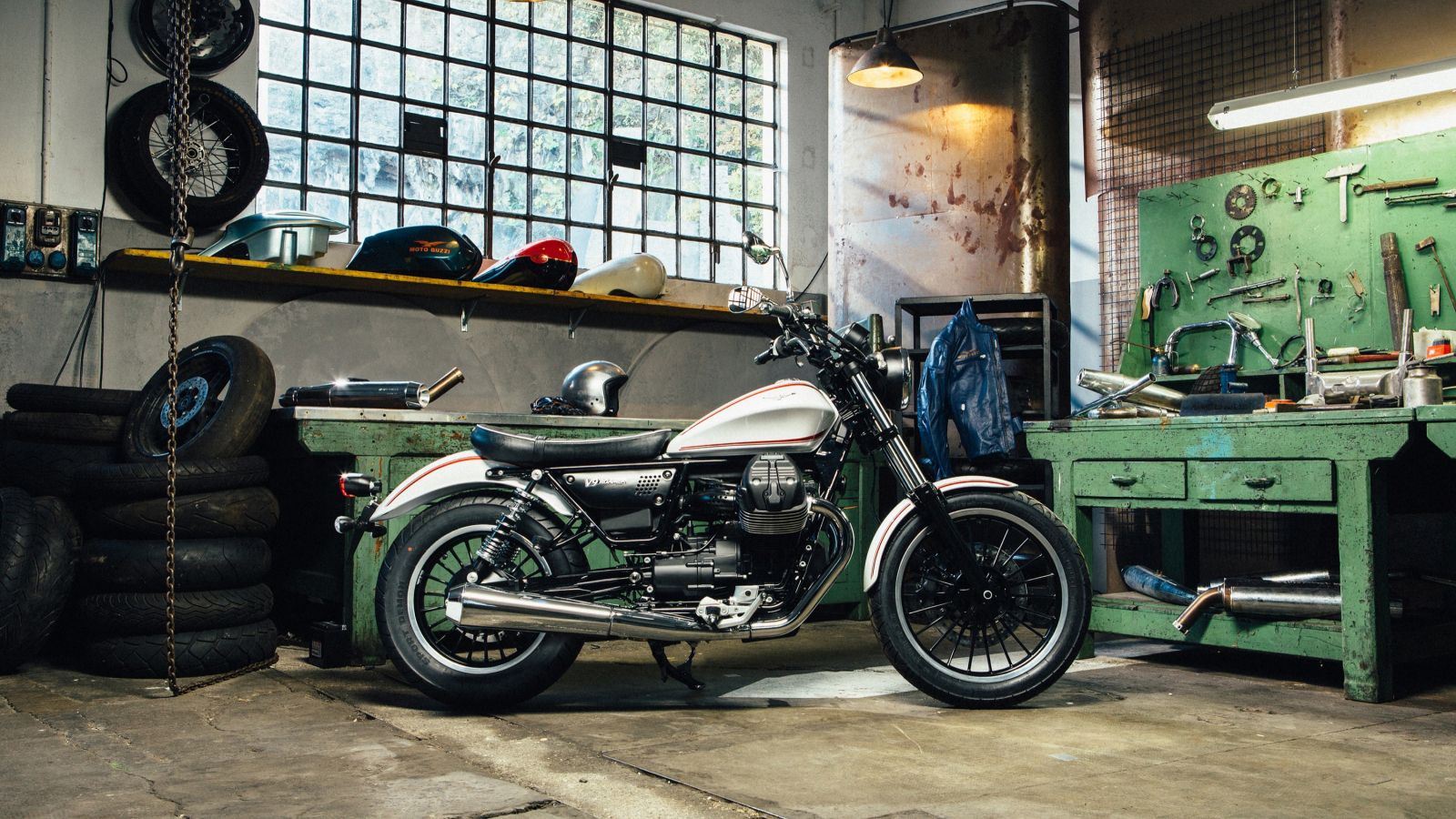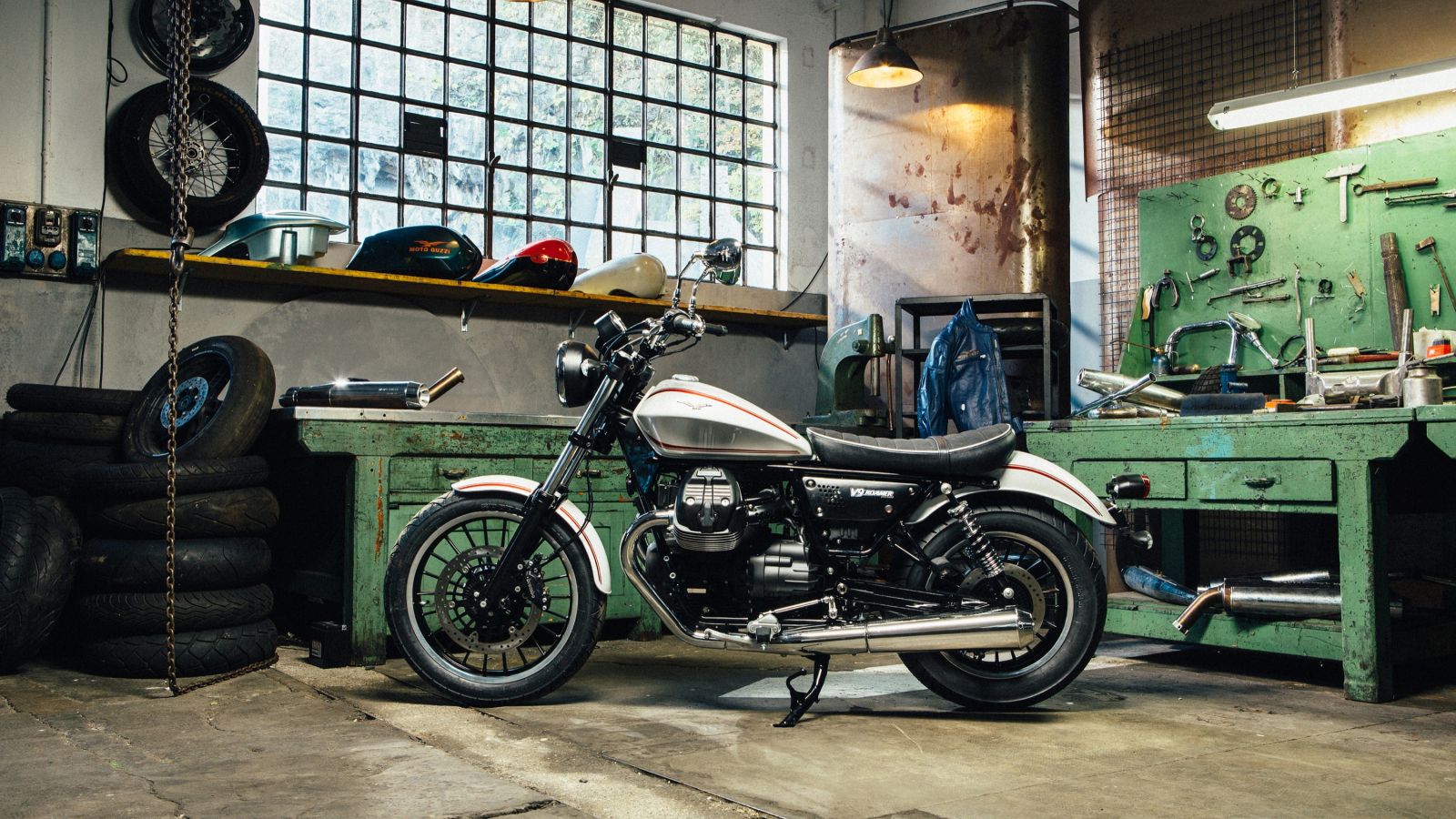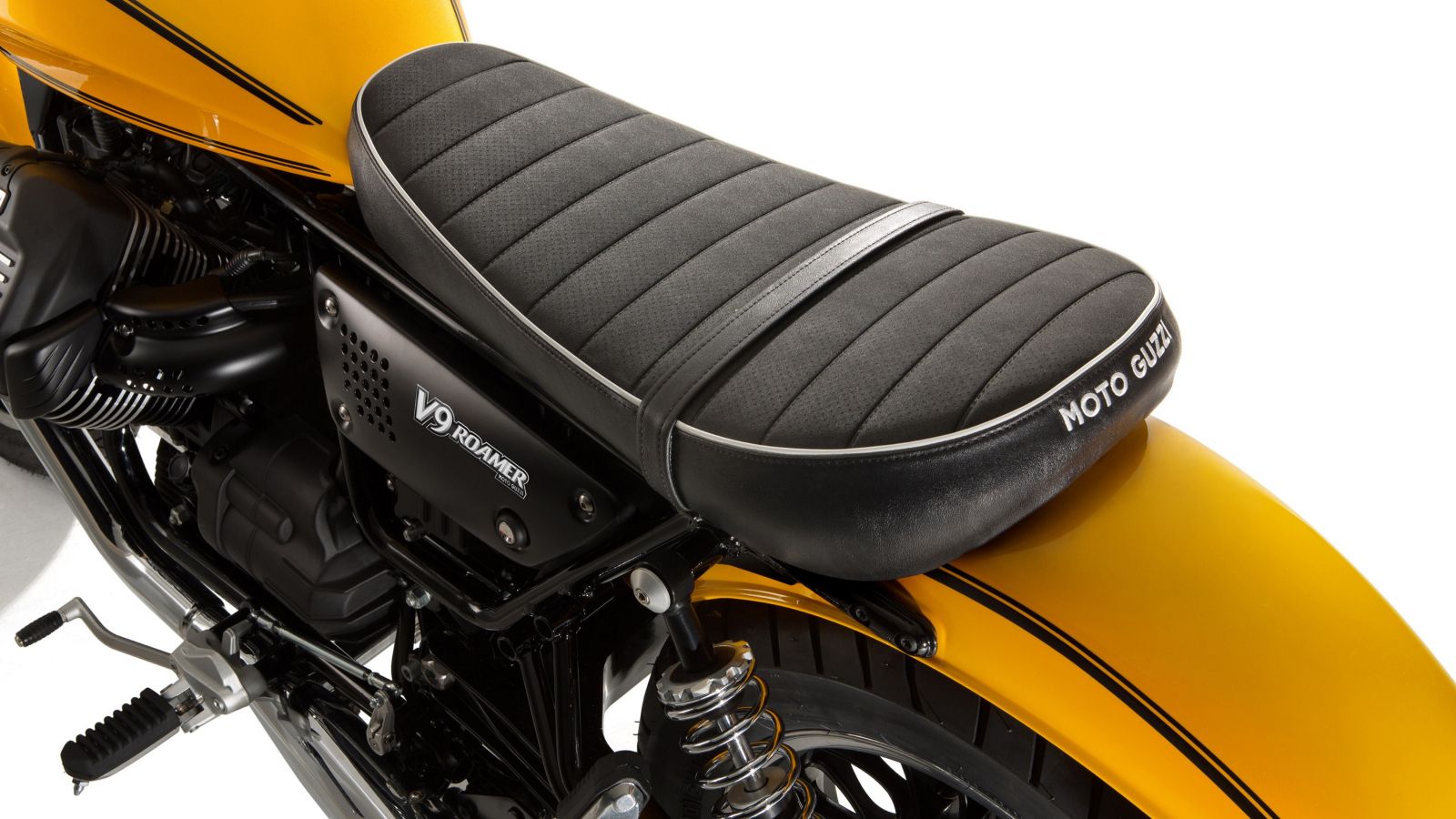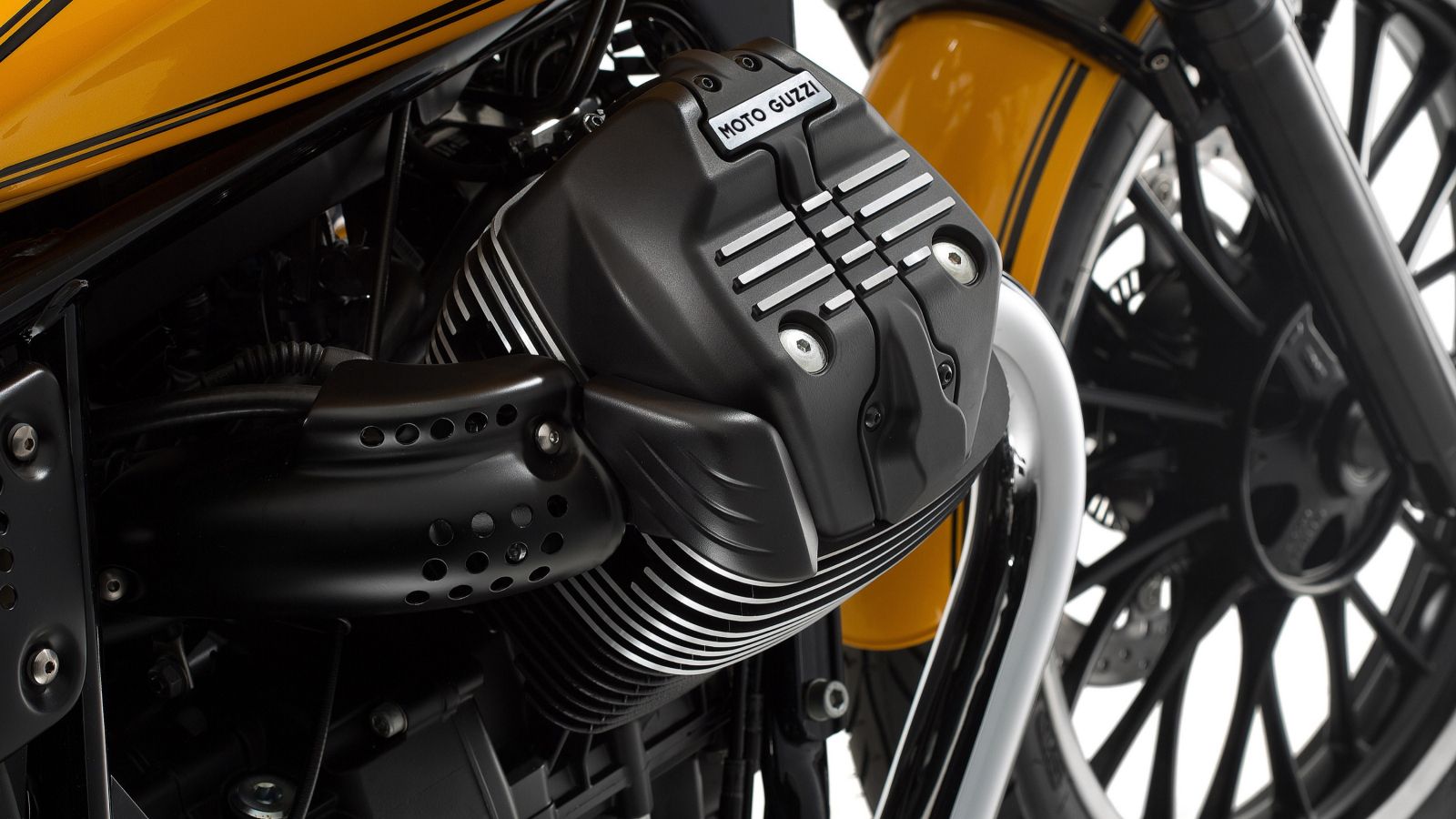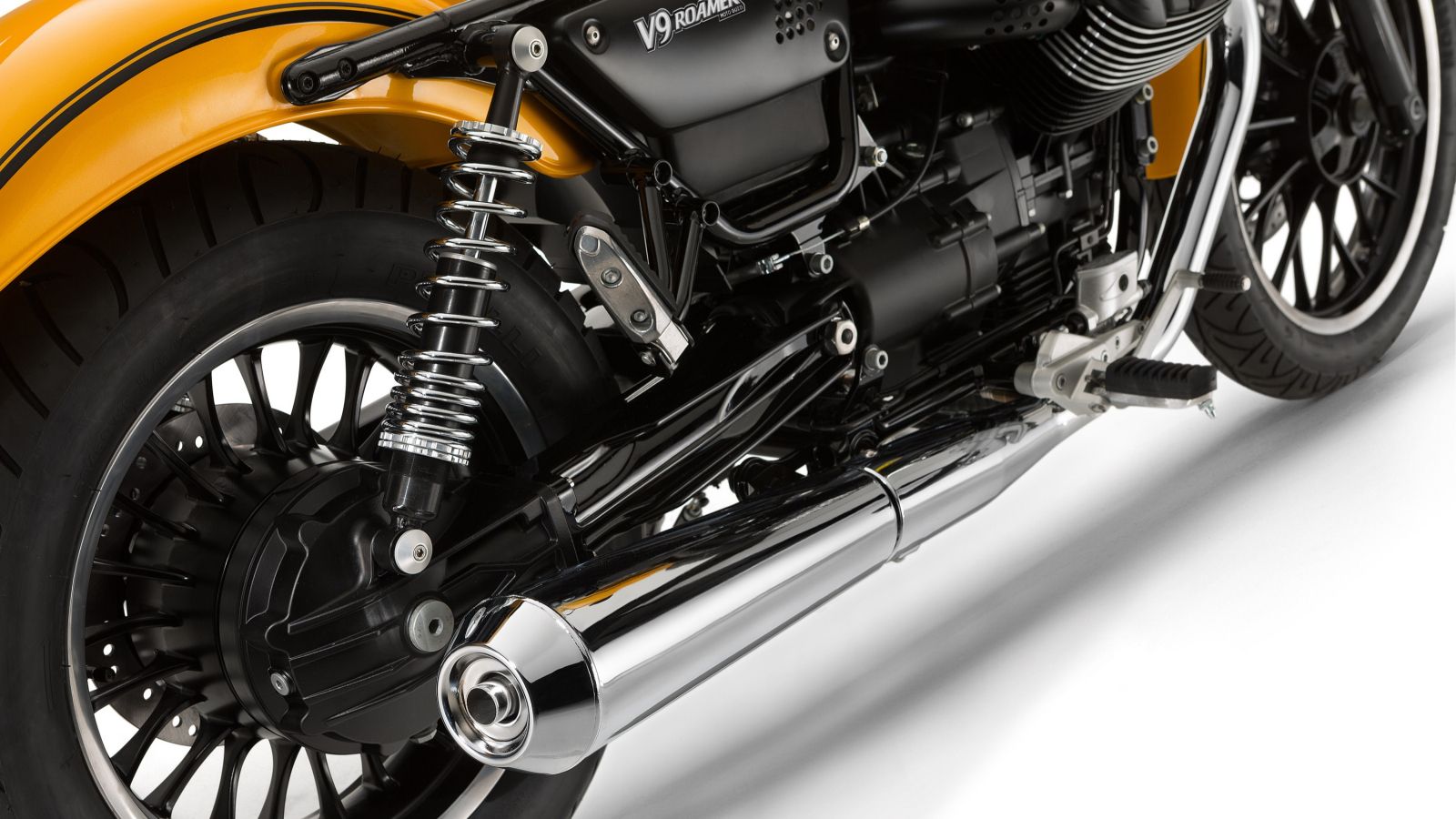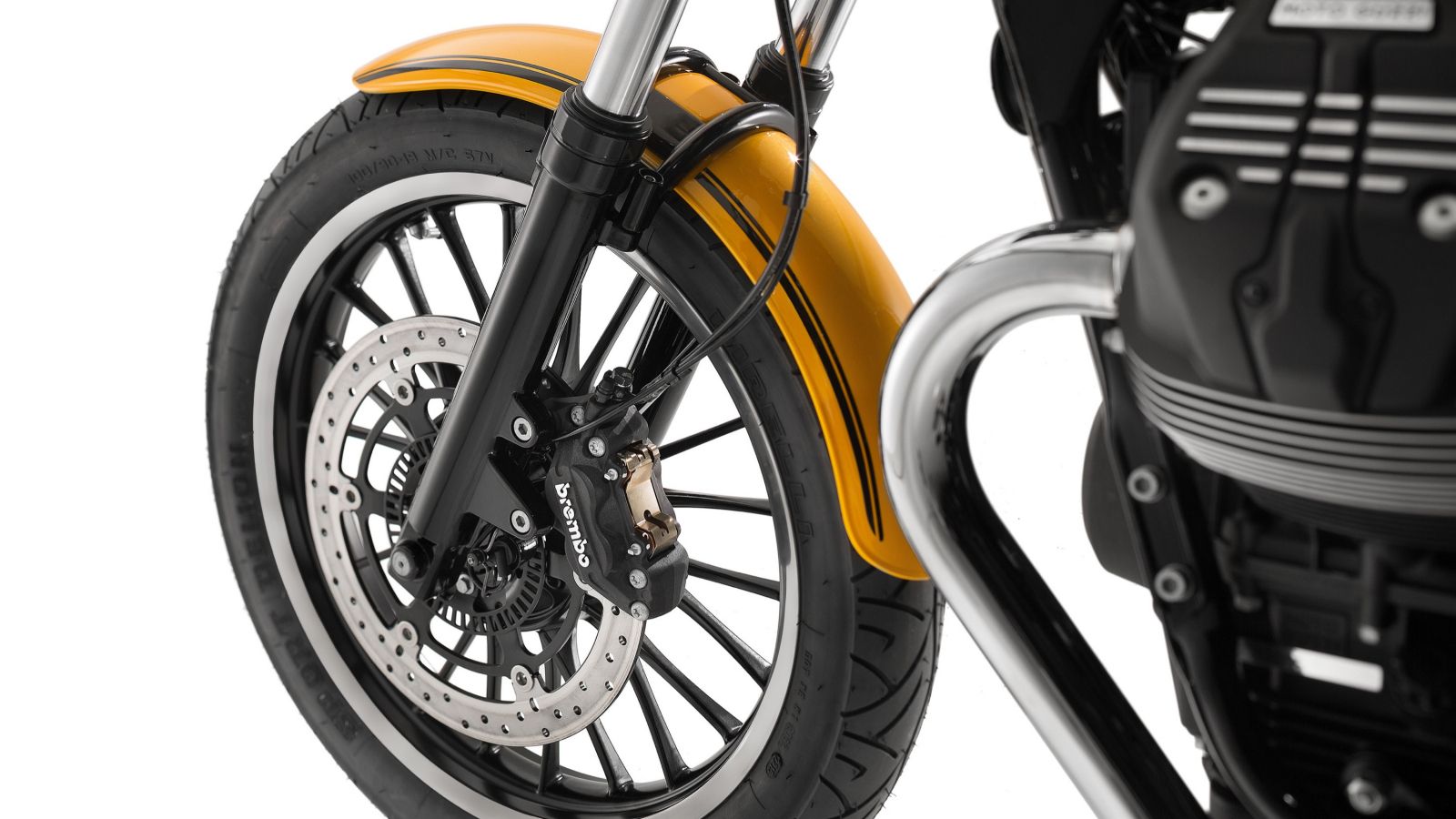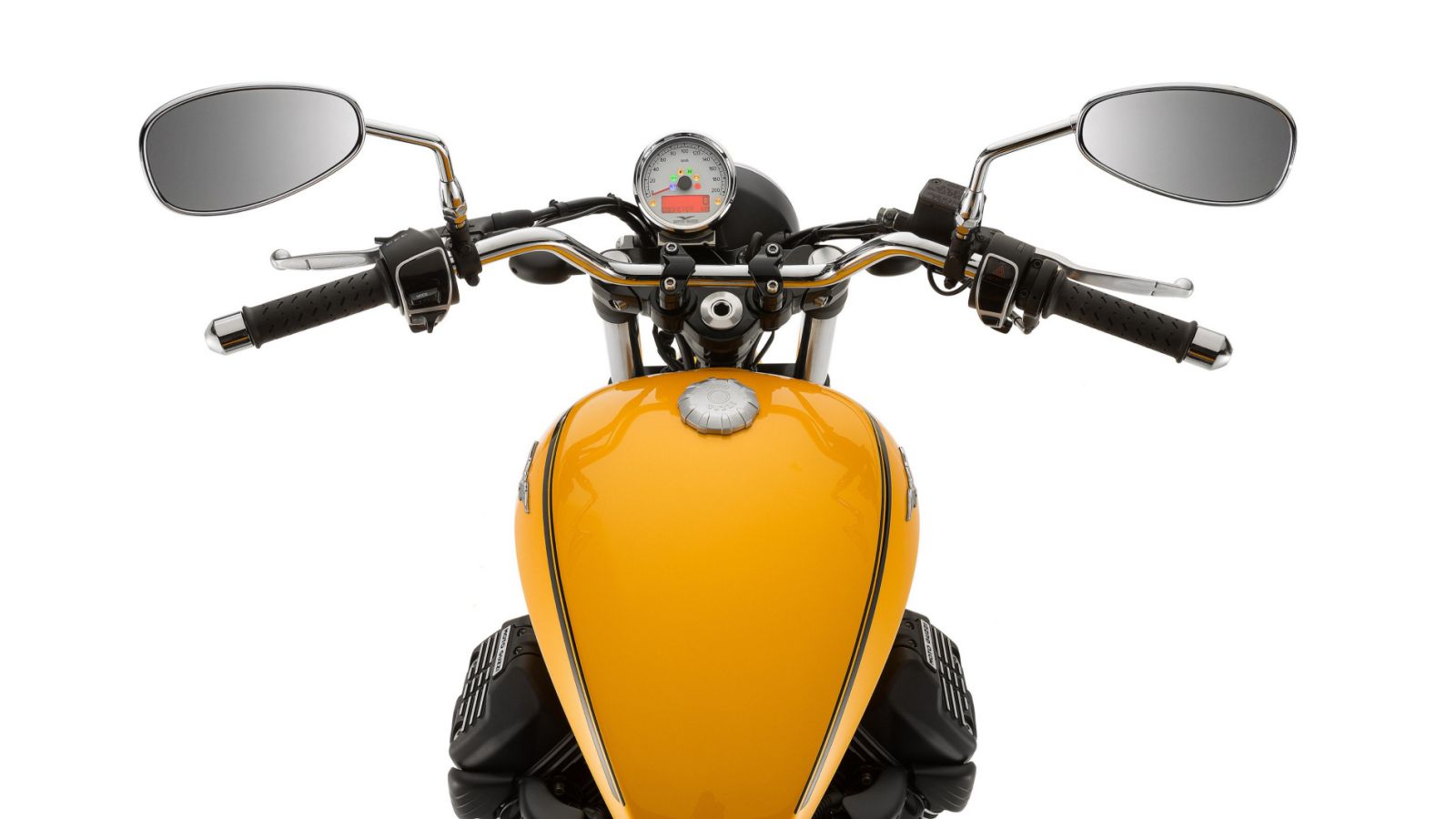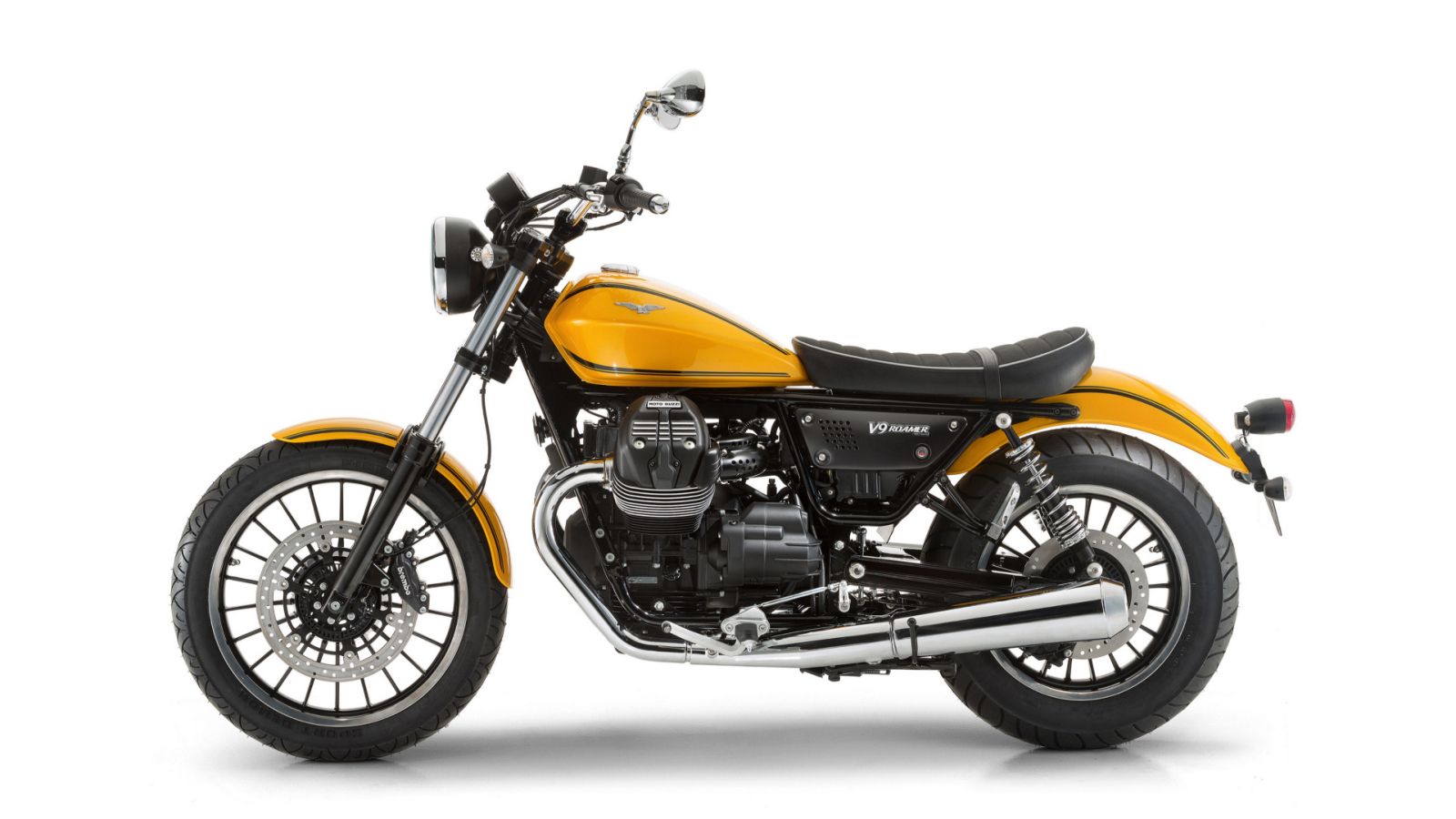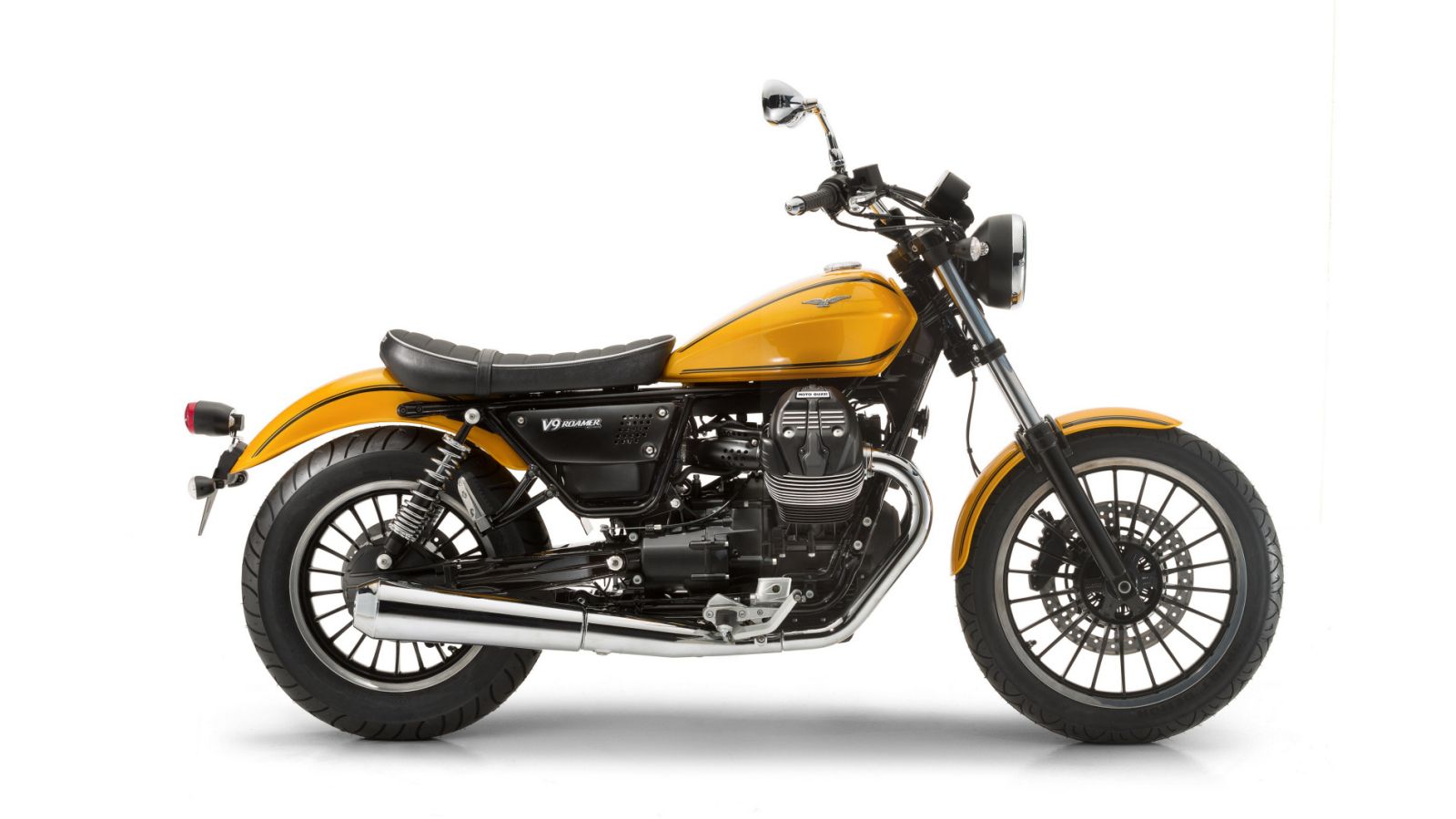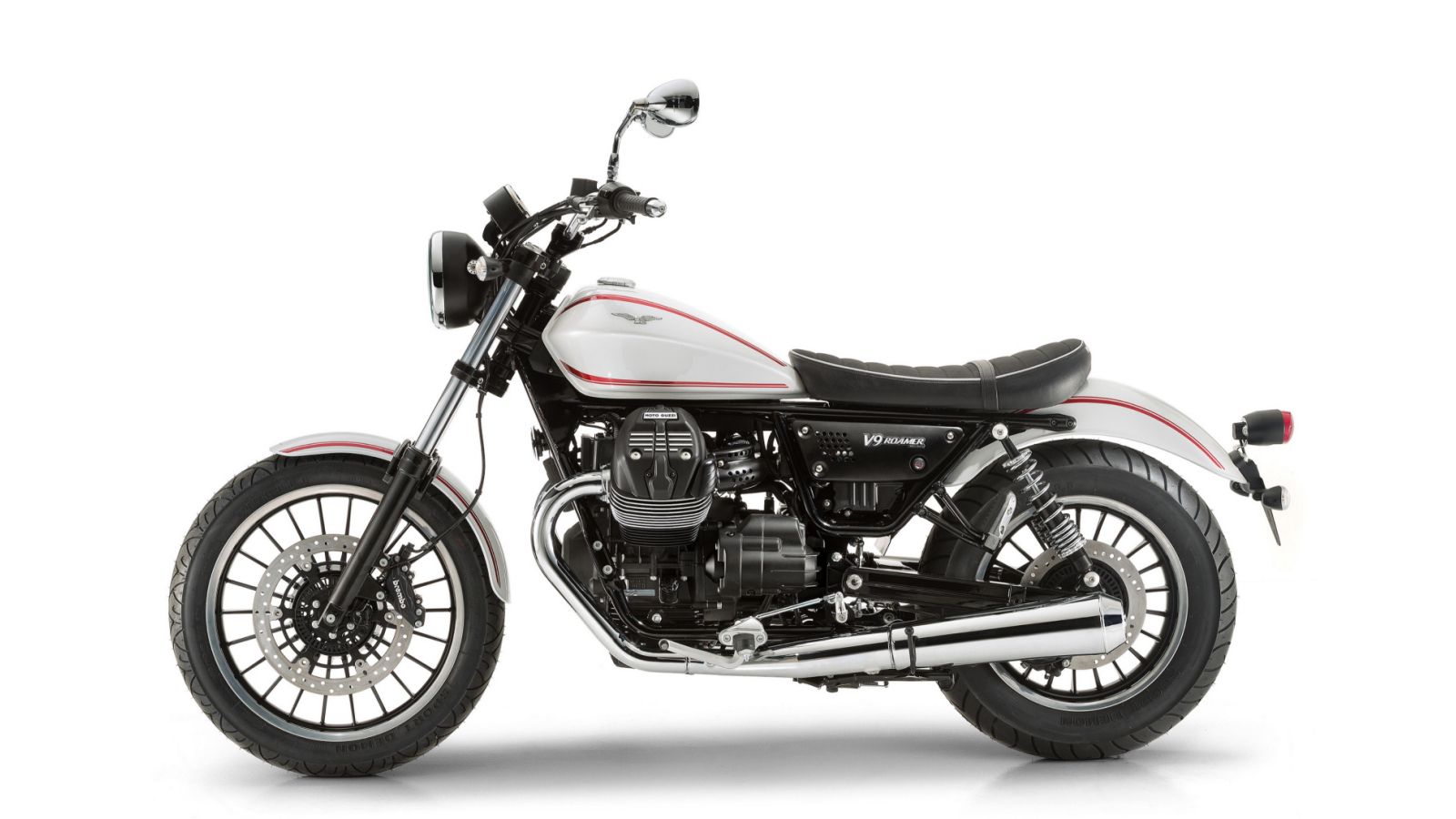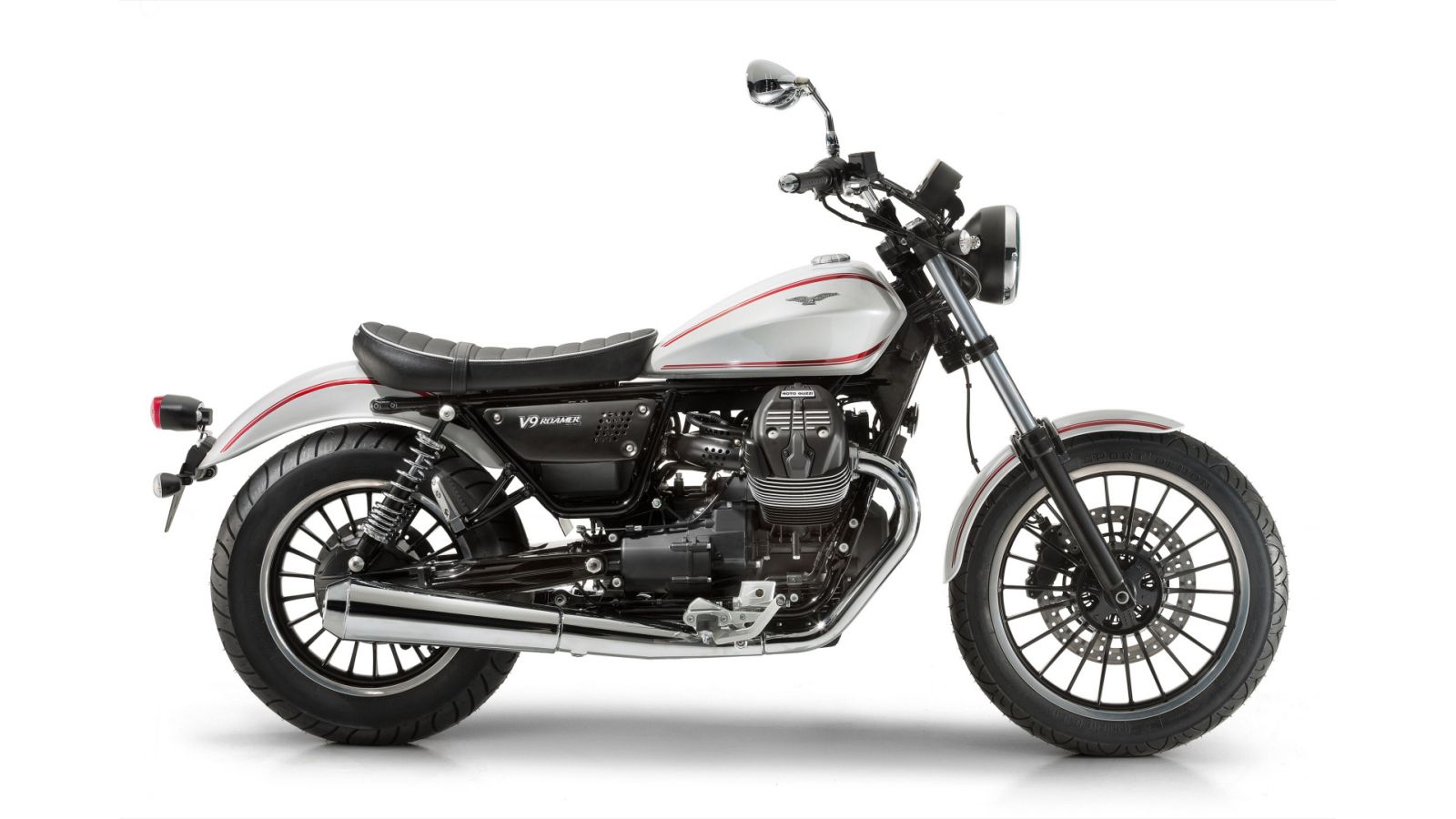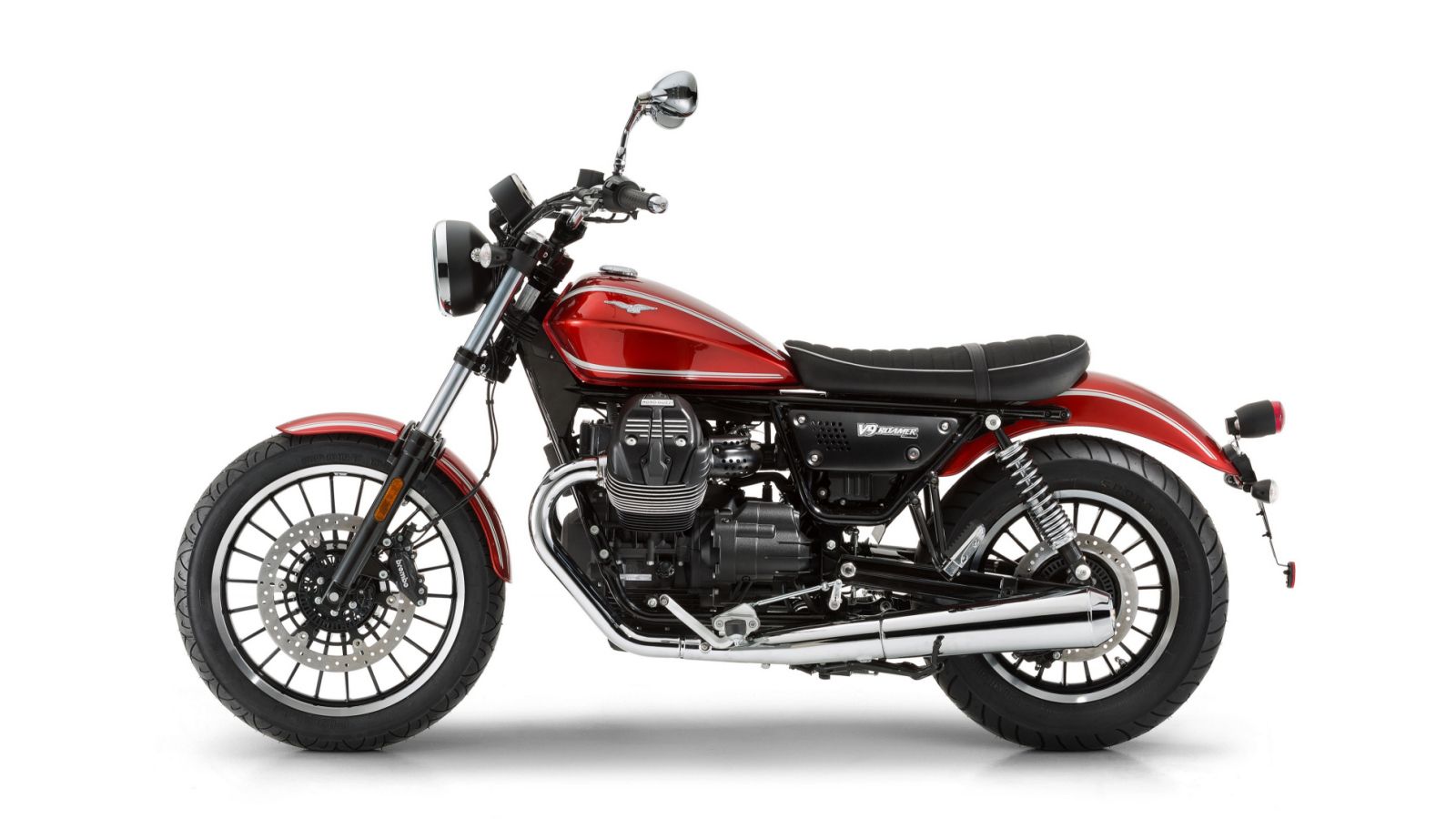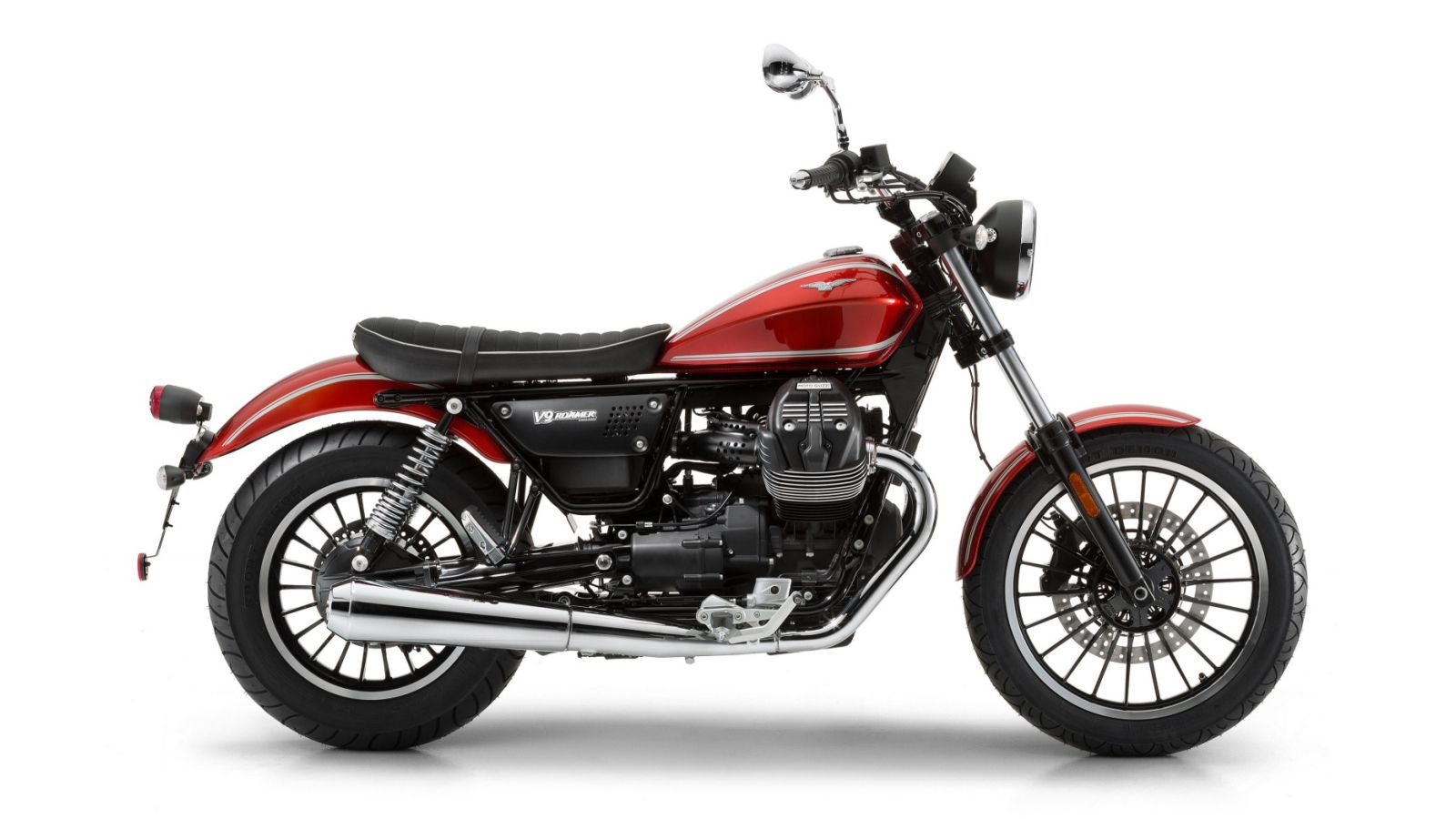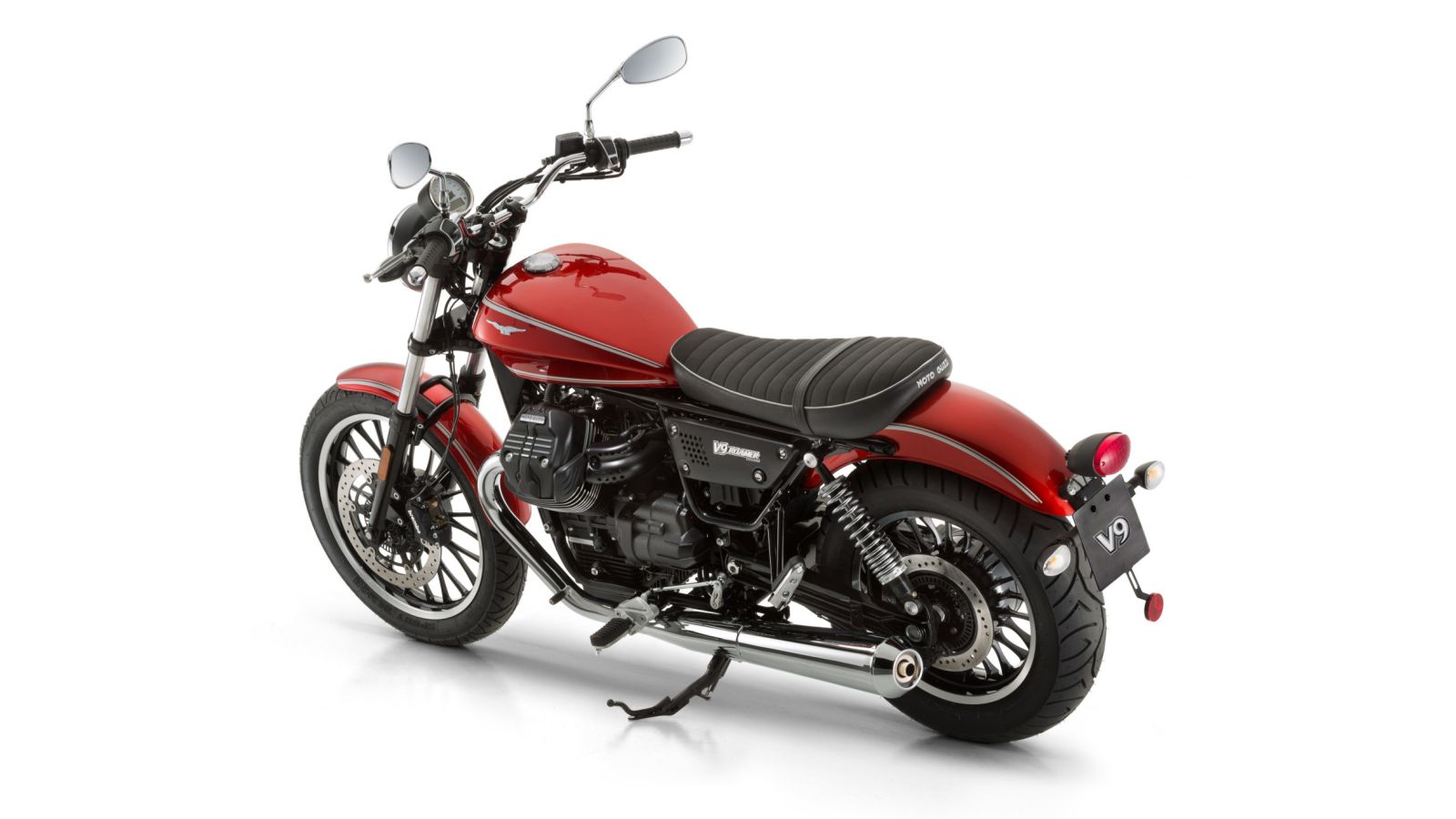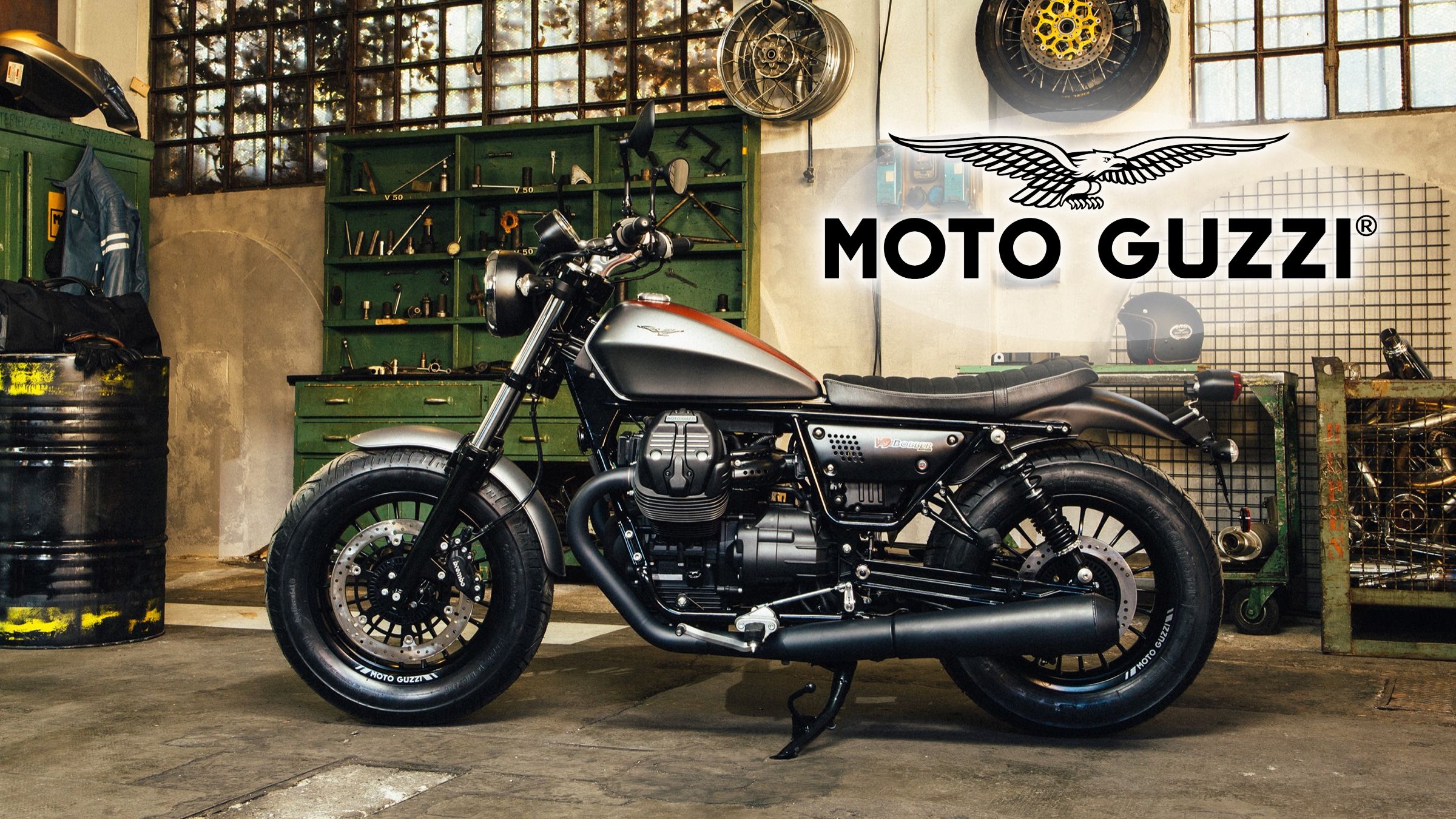Moto Guzzi launched a brand-new model family in 2016 that pays tribute to the past efforts of custom bike builders, of which there are no shortage given 'Guzzi's long history on both sides of the pond. The all-new V9 range included the mainstream-custom “Roamer,” and the more sinister “Bobber” with a more outlaw-looking blackout treatment. Not only was the chassis new, but MG built a brand-new 853 cc engine with which to power this mid-size, standard cruiser.
Continue reading for my look at the Moto Guzzi V9 Roamer and V9 Bobber.
2016 - 2018 Moto Guzzi V9 Bobber & V9 Roamer
- Make: Array
- Model: 2016 - 2018 Moto Guzzi V9 Bobber & V9 Roamer
- Segment: Array
- Engine/Motor: V-Twin
- [do not use] Vehicle Model: Array
Design
These two are really more of a barhopper/grocery-getter that's perfect for around town riding while maintaining a limited road trip capacity. I say “limited” only because it can be rather fatiguing riding a lightweight, short wheelbase bike over long distances at highway speeds, and I would know, having put many state lines behind my Sportsters over the years, but I digress. Many manufacturers are riding the current wave of enthusiasm for custom and classic-looking bikes, and luckily for 'Guzzi, it has its own deep roots to draw upon for inspiration.
If I had to pick an existing family to compare the V9 family to, and I do, I'd say the range is very Sportster-esque in its size and stature. Standard, rwu forks keep the front end looking traditional, maybe even a little dated, and both models sport blackout sliders that start things headed in the homejob-custom direction right off the bat.
From there, the upper lines follow the gentle grade back along the tank down to a very '70s-ish bench seat. Sheet metal is kept to a minimum with only a couple of small side covers in addition to the requisite fenders and fuel tank. The tank itself is rather interesting, with a longitudinal, angular ridge that flares the sides out before narrowing again toward the bottom. Not only does this accentuate the curve of the upper line, but the ridge itself might also be able to pull double duty as a place to hang one's high-side knee on really aggressive corners, but you'll have to tuck it in right next to that hot jug to do so.
Mid-mount footpegs place the rider in a fairly relaxed riding position, and while the Roamer's bars come with some rise and pullback that keeps the rider upright, the Bobber's drag bars pull the rider forward a bit for a sportier rider's triangle and more aggressive stance. As far as the finish goes, the Roamer comes with a fairly typical blend of paint, polished aluminum and chrome, while the Bobber carries an almost total blackout paint scheme with very few highlights to mar the darkness.
Chassis
'Guzzi started out on a double-downtube, double-cradle, tubular ALS-steel frame, a rather traditional format for this type of bike, and one that plays right into the overall look, keeping it old school from the ground up. The steering head in the frame comes set at 26.4-degrees, and an offset in the tripleclamp leaves us with a 38-degree steering angle.
A set of 40 mm forks float the front end on 5.1 inches of travel with fixed preload and damping values, and a pair of coil-over rear shocks on the yoke-style, cast-aluminum swingarm provide 3.8 inches of wheel travel with the usual spring preload adjustment so you can compensate for changing passenger and cargo loads.
Both of the V9 siblings run on cast-aluminum rims, but while the Roamer runs a 100/90-19-front and 150/80-16-rear setup, the Bobber runs a fat, custom-looking 130/90-16 and 150/80-16 set of hoops and rims. This difference in size is what causes the discrepancy in the trail figures; 4.92 inches for the Roamer, and 4.57 inches on the Bobber, but both still fall within the typical range for this style of bike.
The wheelbase is bit different as well, with the Roamer at 57.3-inches long and the Bobber a bit bigger at 58.2-inches long. A four-bore, opposed-piston Brembo caliper pinches the 320 mm front disc, and a two-pot-opposed caliper binds the 260 mm rear disc, all with ABS as part of the standard equipment package.
|
Model: |
V9 Roamer |
V9 Bobber |
|
Frame: |
ALS steel twin tube cradle frame |
ALS steel twin tube cradle frame |
|
Trail: |
125.1 mm |
116.1 mm |
|
Headstock angle: |
26.4° |
26.4° |
|
Steering angle: |
38° |
38° |
|
Front suspension: |
standard fork, Ø 40 mm |
standard fork, Ø 40 mm |
|
Front wheel travel: |
130 mm |
130 mm |
|
Rear suspension: |
swingarm with double shock absorber with adjustable spring preload. |
swingarm with double shock absorber with adjustable spring preload. |
|
Rear wheel travel: |
97 mm |
97 mm |
|
Front Brake: |
stainless steel floating disc, Ø 320 mm Brembo opposed four-piston calipers |
stainless steel floating disc, Ø 320 mm Brembo opposed four-piston calipers |
|
Rear Brake: |
stainless steel floating disc, Ø 260 mm Brembo opposed two-piston calipers |
stainless steel floating disc, Ø 260 mm Brembo opposed two-piston calipers |
|
Wheels: |
Aluminum alloy |
Aluminum alloy |
|
Front wheel rim: |
2.50” x 19” |
3.50” x 16” |
|
Rear wheel rim: |
4.00” x 16” |
4.00” x 16” |
|
Front tire: |
100/90 - 19” |
130/90 - 16” |
|
Rear tire: |
150/80 - 16” |
150/80 B 16” |
Drivetrain
MG has always been about the 90-degree, transverse-mount, V-twin mills, and the V9 family motor is no exception. This brand-new engine comes with a number of improvements meant to minimize power losses in the system, starting with a new crankcase vent in the alternator cover that vents blowby gasses and reduces “pumping” losses in the crankcase, and a low-volume oil pump that consumes less power than previous models.
Air- and oil-cooled, the engine comes with piston-cooling jets that squirt oil up under the pistons to help keep the crown cool, and an oil radiator betwixt the downtubes cools the lifeblood for an extra layer of protection.
Oversquare, the 84 mm bore and 77 mm stroke (plus combustion chambers, times two) adds up to a total of 853 cc with a compression ratio of 10.5-to-1. Twin-valve heads draw from the Marelli MIU fuel-injection system with onboard traction control, and exhaust through a 2-into-2, stainless-steel system with a three-way catalytic converter and twin Lambda probes for Euro 4 emissions compliance. This gives us 45.7 pounds of grunt at a low, 3,000 rpm, and 55 horses at 6,250 rpm, which is plenty of power for some fun on one of these 438-pound (wet) bikes.
A helical-gear primary drive conveys power from the engine to the 170 mm, single-disc dry clutch and six-speed transmixxer, and as usual, a shaft-type final drive makes the connection to the rear wheel.
|
Engine: |
90° V-twin, 4-stroke, 2-valves per cylinder |
|
Cooling system: |
air and oil |
|
Displacement: |
853 cc |
|
Bore x stroke: |
84 x 77 mm |
|
Compression ratio: |
10.5: 1 |
|
Maximum power: |
40.44 kW (55 HP) at 6,250 rpm |
|
Torque: |
62 Nm at 3,000 rpm |
|
Fuel system : |
Marelli MIU single-body electronic injection, integrated management of traction control on 2 levels |
|
Starting: |
electric |
|
Exhaust system: |
stainless steel, 2-in-2 type, three-way catalytic converter with double lambda probe |
|
Gearbox: |
6 speeds with final overdrive |
Pricing
The Roamer rolls for $9,990 and comes in one of three glossy-finish colors; Giallo Solare (Yellow Sun), Bianco Classico (Classic White) or Rosso Rubino (Ruby Red). Coming in just a skosh higher is the Bobber at $10,490, and it comes in Nero Massiccio (Massive Black) or Grigio Sport (Sport Gray). All come with a checker graphic on the fenders and fuel tank for a nice splash of contrast.
|
Model: |
V9 Roamer |
V9 Bobber |
|
Colors: |
Giallo Solare (Solar Yellow), Bianco Classico (Classic White), Rosso Rubino (Ruby Red) |
Nero Massiccio (Solid Black), Grigio Sport (Sports Gray) |
|
Price: |
$9,990 |
$10,490 |
Competitors
|
|
left> 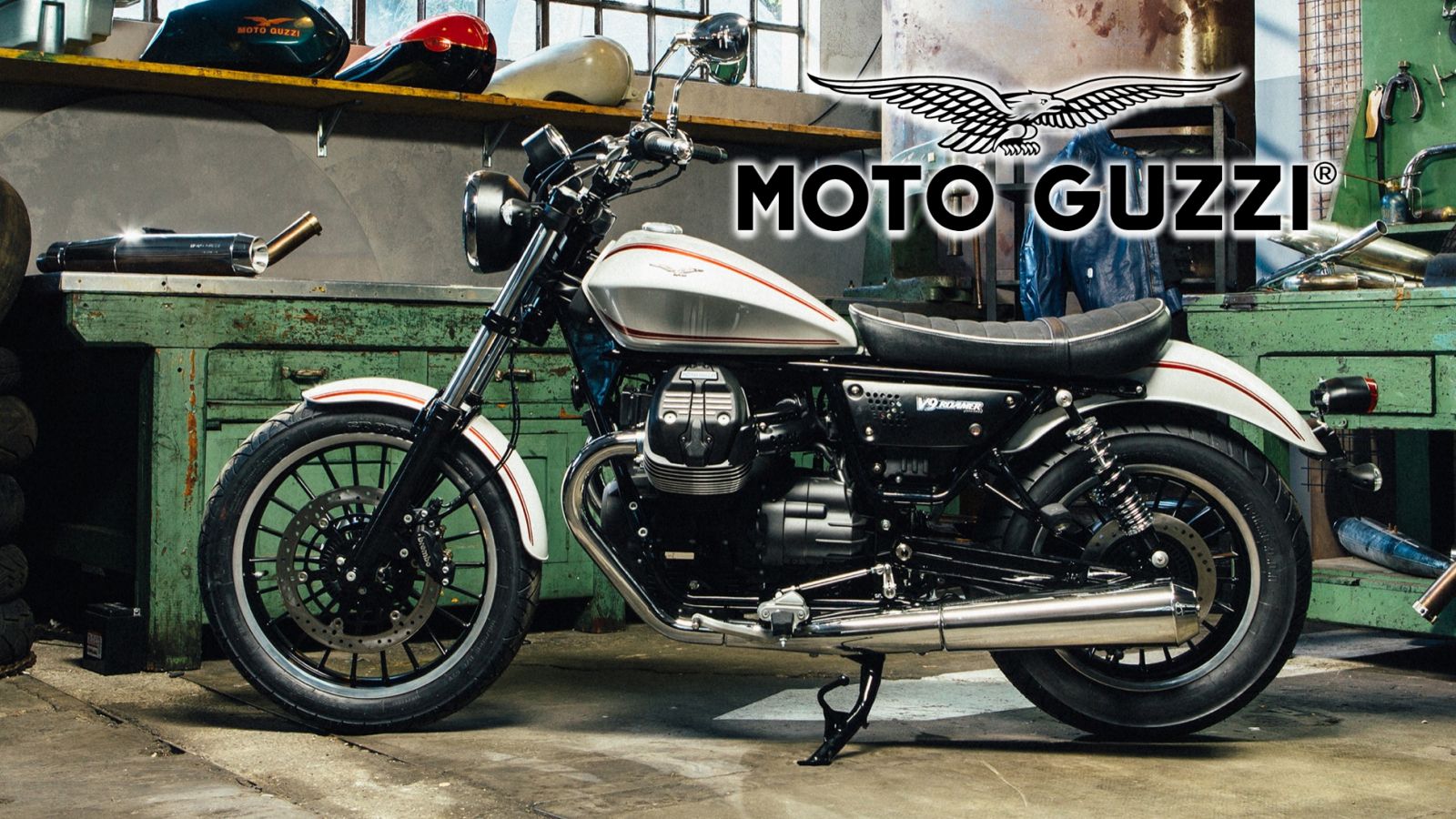
|
Finding a competitor for one of these new 'Guzzi rides was a no-brainer. Sure, I could have scratched around and found a less-obvious choice, but why bother? The Iron 883 is right in line with the Roamer in nearly every important category across the board, and they will likely appeal to the same sort of buyer within the U.S. market with the obvious exception of the die-hard Harley crowd, of course.
Ever the pragmatists, H-D built the Iron with very little embellishment, so it carries only the bare essentials in a straightforward, no-frills presentation. The Roamer is fairly bare as well, but the factory managed to give it a touch of grace and old-world class the Sporty lacks; it's amazing how much difference a little tank detail can add, isn't it?
Gotta say I'm not a fan of the bench seat, though. It's a little boring to look at, and exciting in a not-good way when you romp on the throttle and discover there is nothing to keep the bike from driving right out from under you, and I don't care how tough you are, your butt cheeks can only grip the seat so hard. Banana, er, bench seats like this do have a practical use though; extra-tall riders aren't locked into any particular position on the seat, and are free to ease back a little to make extra room for their gangling appendages. Beyond that, they both look like exactly what they are, mid-size standards in the Western sense of the word.
Features in the rolling chassis are fairly similar, with a single-disc front brake and preload-adjustable rear shocks, and they both share the same shortcomings; namely the lack of any sort of ride adjustment on the forks, or compression- and rebound-damping adjustment on top of the variable spring preload.
Given the relatively light weights that bracket the 500-pound mark -- 438 pounds for the Roamer and 562 pounds for the Iron -- the lack of dual front brakes is not really a cause for concern, though Harley is kind of pushing what I consider to be the safety envelope just a bit. H-D takes a hit with the ABS though, if you are into that sort of thing. Although it is available as a $795 option on the Iron, it comes as standard equipment on the 'Guzzi. Same thing with the security system; standard on the Roamer, but a $395 option on the Iron.
Now for the powerplants. The Sporty runs the 30-year old, 883 cc Evolution engine, and while this might seem a tad long in the tooth to still be relevant in today's market, I submit to you that the age just means Harley has had plenty of time to perfect it. MG built a nearly brand-new, 853 cc engine to drive the V9 family. I say nearly because only 90% of the engine components are in fact new, the remaining 10% are pre-existing parts, but the salient point is that this new mill is something of an unknown as yet, and it will take some time before we see how good it is over the long run.
Meanwhile we are left with the power metrics to consider. MG does OK for itself with 45.7 pound-feet of torque at 3 grand, while H-D manages to milk 53.8 pounds of grunt out of the Evo motor at 3,750 rpm. That's all good and fine for Harley as far as it goes, unfortunately, that's all the further it goes. MG shows us some electronic love in the form of an integral traction-control system, something Harley has yet to do, and as much as I kind of pooh-pooh ABS sometimes, I think traction control is a fabulous idea, and implore Harley yet again to get on that bandwagon.
Now for the pricing, and bear in mind the cost of the Harley options that come standard with the 'Guzzi. The base-model Roamer rolls for just a hair under 10 K at $9,990, while the Iron 883 starts out at $8,999. Add the options that are inclusive with the Roamer, and the Iron ooches up over 10 grand. Harley maintains its position as the King of Paint, with some very attractive finishes, but also maintains it's reputation for being a little bit proud of said paint with a $9,449 sticker on the Hard Candy paint. Add options on top of that and you will wreck 12 grand. In short, the Iron is less expensive, but you get a bit more for your money with the Roamer.
He Said
“I really kind of like the Bobber more than the Roamer, and although I'm not wild about the seat, there's always the aftermarket. I can see a solo seat with a tail-tidy cleaning up the look quite nicely. This family does indeed make a nice alternative to the Sporty, or any of the similar Japanese offerings, and would make a suitable first bike/trainer for someone looking to break into riding with plans to move to large-displacement cruisers at some point.”
She Said
My wife and fellow motorcycle writer, Allyn Hinton, says, “The new engine, despite what I'd heard very early on, is not just a bored and stroked V7 mill. This new 853 cc engine has redesigned heads and combustion chamber, among other things. This whole resurgence of the retro styled-bikes has folks looking at Guzzi again. I guess if you hold on to your own fashion long enough, it comes back into style.”
Specifications
|
Models: |
V9 Roamer |
V9 Bobber |
|
Engine & Drivetrain: |
||
|
Engine: |
90° V-twin, 4-stroke, 2-valves per cylinder |
90° V-twin, 4-stroke, 2-valves per cylinder |
|
Cooling system: |
air and oil |
air and oil |
|
Displacement: |
853 cc |
853 cc |
|
Bore x stroke: |
84 x 77 mm |
84 x 77 mm |
|
Compression ratio: |
10.5: 1 |
10.5: 1 |
|
Maximum power: |
40.44 kW (55 HP) at 6,250 rpm |
40.44 kW (55 HP) at 6,250 rpm |
|
Torque: |
62 Nm at 3,000 rpm |
62 Nm at 3,000 rpm |
|
Fuel system : |
Marelli MIU single-body electronic injection, integrated management of traction control on 2 levels |
Marelli MIU single-body electronic injection, integrated management of traction control on 2 levels |
|
Starting: |
electric |
electric |
|
Exhaust system: |
stainless steel, 2-in-2 type, three-way catalytic converter with double lambda probe |
stainless steel, 2-in-2 type, three-way catalytic converter with double lambda probe |
|
Emissions compliance: |
Euro 4 |
Euro 4 |
|
Gearbox: |
6 speeds with final overdrive |
6 speeds with final overdrive |
|
Gear ratio values: |
||
|
1st: |
16/39 = 1: 2.437 |
16/39 = 1: 2.437 |
|
2nd: |
18/32 = 1: 1.778 |
18/32 = 1: 1.778 |
|
3rd: |
21/28 = 1: 1.333 |
21/28 = 1: 1.333 |
|
4th: |
24/26 = 1: 1.083 |
24/26 = 1: 1.083 |
|
5th: |
25/24 = 1: 0.96 |
25/24 = 1: 0.96 |
|
6th: |
28/24 = 1: 0.857 |
28/24 = 1: 0.857 |
|
Primary drive: |
with helical teeth, ratio 21/25 = 1: 1.190 |
with helical teeth, ratio 21/25 = 1: 1.190 |
|
Final drive: |
double universal joint and double bevel gear units (8/33 ratio = 1: 4.125) |
double universal joint and double bevel gear units (8/33 ratio = 1: 4.125) |
|
Clutch: |
Ø 170 mm single disc with integrated flexible couplings |
Ø 170 mm single disc with integrated flexible couplings |
|
Chassis: |
||
|
Frame: |
ALS steel twin tube cradle frame |
ALS steel twin tube cradle frame |
|
Wheelbase: |
1,465 mm |
1,465 mm |
|
Trail: |
125.1 mm |
116.1 mm |
|
Headstock angle: |
26.4° |
26.4° |
|
Steering angle: |
38° |
38° |
|
Front suspension: |
standard fork, Ø 40 mm |
standard fork, Ø 40 mm |
|
Front wheel travel: |
130 mm |
130 mm |
|
Rear suspension: |
swingarm with double shock absorber with adjustable spring preload. |
swingarm with double shock absorber with adjustable spring preload. |
|
Rear wheel travel: |
97 mm |
97 mm |
|
Front Brake: |
stainless steel floating disc, Ø 320 mm Brembo opposed four-piston calipers |
stainless steel floating disc, Ø 320 mm Brembo opposed four-piston calipers |
|
Rear Brake: |
stainless steel floating disc, Ø 260 mm Brembo opposed two-piston calipers |
stainless steel floating disc, Ø 260 mm Brembo opposed two-piston calipers |
|
Wheels: |
Aluminum alloy |
Aluminum alloy |
|
Front wheel rim: |
2.50” x 19” |
3.50” x 16” |
|
Rear wheel rim: |
4.00” x 16” |
4.00” x 16” |
|
Front tire: |
100/90 - 19” |
130/90 - 16” |
|
Rear tire: |
150/80 - 16” |
150/80 B 16” |
|
Electrics: |
||
|
System voltage: |
12 V |
12 V |
|
Battery: |
12V - 18 Ah |
12V - 18 Ah |
|
Dimensions & Capacities: |
||
|
Length: |
2,240 mm |
2,185 mm |
|
Width : |
865 mm |
840 mm |
|
Height : |
1,165 mm |
1,160 mm |
|
Saddle height: |
785 mm |
780 mm |
|
Wheelbase: |
1,465 mm |
1,465 mm |
|
Kerb weight: |
199 Kg |
199 Kg |
|
Fuel tank capacity: |
15 litres |
15 litres |
|
Reserve: |
4 litres |
4 litres |
|
Details: |
||
|
Colors: |
Giallo Solare (Solar Yellow), Bianco Classico (Classic White), Rosso Rubino (Ruby Red) |
Nero Massiccio (Solid Black), Grigio Sport (Sports Gray) |
|
Price: |
$9,990 |
$10,490 |
References
Harley-Davidson Iron 883
See our review of the Harley-Davidson Iron 883.


